MAGAZINE



Philip Newton, Bill Whaley and Chad Carter (l-r)
NC State University’s Lake Wheeler Road Field Lab

Continued on page 42
Stories from NC State’s College of Agriculture and Life Sciences
A landmark research and education farm tucked into the state’s fast-growing capital city serves as a critical asset for North Carolina’s largest industry.

As major companies pledge support for regenerative agriculture, consumers and growers have important questions. For starters, what exactly is it? And can it play a role in North Carolina agriculture’s future?
Discontent with the status quo, Terri Long, Marvin Moncada and Kenny Sherin are creating life- and industry-altering change.
Some children haven’t had the opportunity to enjoy themselves and make memories at summer camp. 4-H agents and staff are working hard to change that.
42
ONLINE EDITION go.ncsu.edu/CALSMagazine
On the cover > Just as Yates Mill represented progress for rural Wake County in the 18th century, NC State’s Lake Wheeler Road Field Laboratory, its neighbor in south Raleigh, powers positive change for people in North Carolina and beyond. Read more about the field lab in this issue and more about Yates Mill in our exclusive story online.
Photo by Charles Dickens.
“Here’s what you should write:
‘Bridget Lassiter couldn’t do her job without them—and she wouldn’t want to.’”
Bridget Lassiter
Superintendent, Lake Wheeler Road Field LabTHE INTERIM DEAN
Whether change happens slowly or quickly, it happens. The key is how we adapt to, manage and lead change.
In the College of Agriculture and Life Sciences, we are doing all three. As our society becomes more technologically dependent and reliant on the internet, our Extension programs continue helping rural communities, stakeholders and the public access connective technology.
As North Carolina’s climate becomes more unpredictable, we are helping farmers adapt to the shifting environment by encouraging practices that make their soils, crops, equipment and production techniques more resilient. In doing this, we help their operations remain profitable.
Underlying this work is plant, animal, ecological, community and food science research that provides the knowledge we need to adapt and manage change—exemplified by the Lake Wheeler Road Field Lab, which serves as a model farm of the future.
The new CALS strategic plan, Growing Our Future, charges us to spearhead change. Based on our values—living the land-grant mission, collaboration, integrity, people-focus and sustainability—we will lead new initiatives in the college and across our industries, such as creating interdisciplinary research sites and expanding our partnerships with historically Black colleges and universities.
But innovations are impossible without investing in our college’s most valuable infrastructure: people.
We equip students with the technical knowledge and professional skills to succeed. We support our faculty and staff in effectively generating new knowledge and innovative solutions, sharing information and teaching others. We help our departments, centers, counties, stations, college offices and programs fulfill their purpose and
make a difference. We are working to ensure the success of external stakeholders as critical partners in our land-grant mission.
We do all this while promoting well-being and belonging within our vast community. Our future depends on all of us working together.
Our college continues to flourish through dedicated leadership, committed partners, and equipped students, faculty and staff, all working together to help North Carolina navigate change for decades to come.

MacKenna Clifton, a junior in the College of Agriculture and Life Sciences, is one of six new National FFA officers for 2022-23 elected at the 95th annual National FFA Convention and Expo this year in Indianapolis, Indiana.
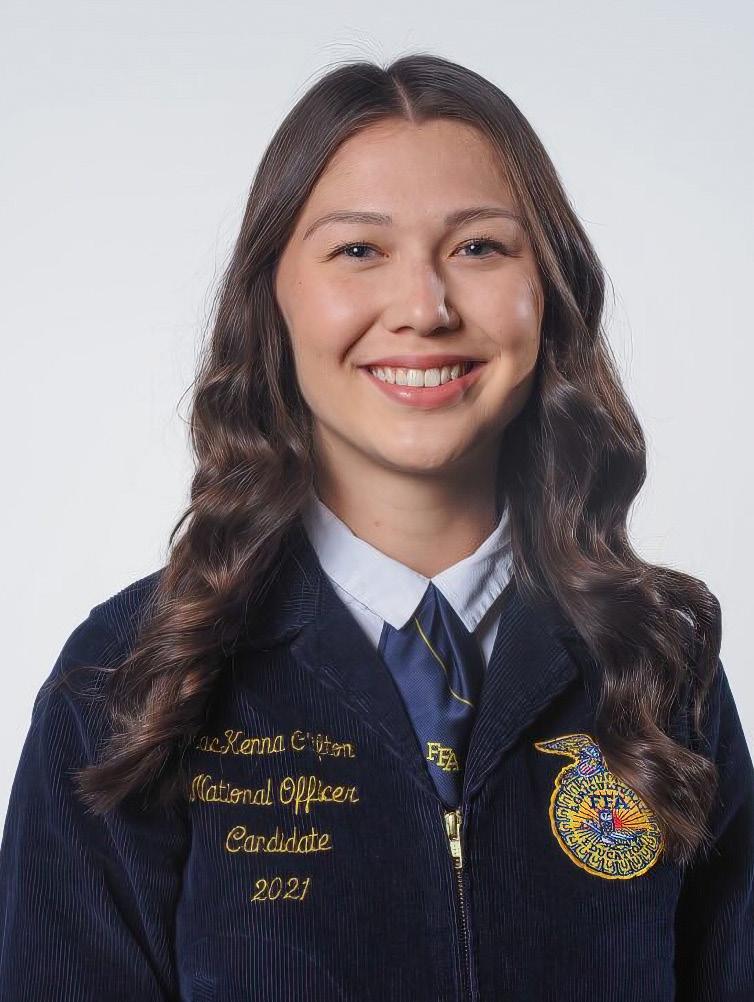
Clifton will serve as southern region vice president. The last time a National FFA officer was selected from North Carolina was the 1995-96 election, according to Joshua Bledsoe, state agricultural education leader at North Carolina State University and state FFA adviser.
Election to the position was no small feat. Clifton was among 35 candidates out of more than 850,000 FFA members who went through a rigorous interview process with the National FFA Officer Nominating Committee, a committee of students.
“MacKenna was an exemplary leader for the North Carolina FFA Association when she served as a state FFA officer; I can’t wait to see the impact she will have nationally as she serves as the national FFA southern region vice president this year,” Bledsoe said. “The entire state is proud of MacKenna, and we know that her leadership will further the mission of FFA.”
Clifton served as the 2020-21 North Carolina FFA vice president. She is from Salisbury, North Carolina, and a member of the West Rowan FFA Chapter. At NC State, she is studying agricultural education and minoring in Spanish and agricultural business management.
During her one-year term as a national FFA officer, she’ll have the opportunity to travel the country to present leadership workshops to FFA members. She’ll also serve as a representative for student leadership for FFA with agriculture, food and natural resources businesses and organizations.
“I want to use the resources I have to reach people where they are and however I can,” Clifton said in an interview with NC State shortly after her election. “Our organization became home to me, and I genuinely believe it can be a home for all.”
LEA HARTThrough agricultural education and North Carolina FFA, students have opportunities for leadership development, personal growth and career success. To learn more, visit NCFFA.org.
“Our organization became home to me, and I genuinely believe it can be a home for all.”
MacKenna Clifton
Two North Carolina State University faculty members interested in leadership education and student success are making headway in building relationships between tribal communities and higher education.
Jackie Bruce and Katherine McKee are exploring ways to support tribal students on their path to higher education and increase their retention and graduation rates with a New Beginnings for Tribal Students grant from the U.S. Department of Agriculture’s National Institute for Food and Agriculture.
“Creating pathways and opportunities for students is what really drew us to this project,” Bruce says. “There’s a real desire among faculty and staff at NC State to learn more about tribal communities and how to better serve tribal students.”
Bruce says applying for the grant was a no-brainer. “We knew the college would be super supportive, and they have been,” Bruce explains. The COVID-19
pandemic didn’t deter McKee and Bruce. Determined to carry out their work, they quickly shifted gears and turned their in-person events into virtual ones.
“Our overarching goals are to create places at NC State that youth from Eastern Band of the Cherokee would be comfortable coming to and feeling like they belong to pursue their degrees,” says McKee.

Now in their third year, McKee and Bruce, both with the Department of Agricultural and Human Sciences, are still figuring out better ways to create these relationships. One thing that’s proved to be crucial is having a dedicated local liaison to communicate with students and their families.
“We’ve learned a ton through this process, and there are still so many opportunities to create more partnerships,” says Bruce. “It’s very exciting and could be incredible for our college.”
KRISTIN SARGENTWen Rivero came to NC State with a chemical engineering degree, some farm experience and the desire to work on big questions in food science but wasn’t sure how it would all come together.
Rivero, who uses they/them pronouns, says NC State stood out as a place where engineers could join the food science department. Through an internship, they discovered interests in data analysis and big-picture ideas to improve operations.
“Then, somehow, the stars aligned,” Rivero says. Deepti Salvi, an assistant professor of food engineering, had a project that needed someone “who had an engineering degree, knew how to grow plants and how to grow plants for engineering purposes.”
The project involved using plasma-activated water to increase the safety of fresh hydroponic produce. As Rivero explains, cold plasma, which can be created by passing electricity through gas, offers advantages over traditional sanitizers because it can be produced at atmospheric pressure and at or near room temperature.
Still, “using cold plasma in the food industry is very complex and with many variables, so I spent a lot of time using different equipment to treat air, water and finally produce,” Rivero adds.
Rivero’s research has shown that basil, strawberries, blackberries and blueberries respond well to plasma treatment.
“If this comes to market and scale-up occurs in a successful way, we could design equipment and bring technologies that could save hundreds of thousands of liters of water in terms of treatment, disposal and cost,” Rivero says.

Rivero, who earned a Ph.D. in food science in 2022, hopes to pursue a career in continuous improvement or process engineering.

“I did a lot of research on plasma, but I also got a lot of transferable skills, such as project management, quality validation, safety validation and understanding regulations,” Rivero says. “In 10 years, it would be amazing if I could get to the level of a plant manager, and the food industry is a long-term goal.”
JULIANA PROFFITT MCCULLYArt Director
Staff Writers
D’Lyn Ford
Dee Shore
Patty Anthony Mercer
Simon Gonzalez, Julie Hayworth-Perman, Sam Jones, Emma Macek, Kristin Sargent, Dee Shore, Alice Manning Touchette
As a graduate student in North Carolina State University’s Department of Applied Ecology, Emily Reed hunted for a mosquito superhighway, investigating how sidewalks and roads may correlate with the spread of the invasive Asian tiger mosquito. Today, she’s adding to our invasive species knowledge as a postdoctoral researcher at Virginia Tech.
Contributing
Writers
Copy Editor
Photography
Videography
Digital Design
Creative Team
Interim Dean
John Dole
Lea Hart, Jennifer Howard, Chelsea Kellner, Juliana Proffitt McCully
Gregor Meyer
Charles Dickens, Marc Hall, Becky Kirkland, Catie Spell
Keeshan Ganatra, Chris Liotta
Leighann Vinesett
Janine Brumfield, Caro Metzler
Senior Associate Dean for Administration
Harry Daniels
Associate Dean and Director, NC State Extension
Richard Bonanno
Associate Dean and Director, N.C. Agricultural Research Service
Steve Lommel
Interim Associate Dean and Director, Academic Programs
Kimberly Allen
Assistant Dean and Director, CALS Advancement
Sonia Murphy
Interim Chief Communications Officer
Kionna Coleman
Visit Us Online > cals.ncsu.edu
NC State University promotes equal opportunity and prohibits discrimination and harassment based upon one’s age, color, disability, gender identity, genetic information, national origin, race, religion, sex (including pregnancy), sexual orientation and veteran status.
Send correspondence and requests for change of address to CALS Magazine Editor, Campus Box 7603, NC State University, Raleigh, NC 27695 -7603.
9,500 copies of this public document were printed at a cost of $1.28 per copy.
After finishing her Ph.D. in July 2021, Reed shifted her focus to science policy as she began developing a database that combines policy information for invasive species with their biological data.
“Having information in one place is really critical for policymakers and resource managers and also for biologists,” she says.
Reed feels grateful for the networking and leadership opportunities she had at NC State.
“I was really set up for success. It’s a good feeling to know that people are rooting for you.”
After finishing her postdoctoral studies, Reed plans to couple research and community engagement related to biological invasions. She also hopes to build a science-related tattoo collection, adding a lionfish, a spadefoot toad and English ivy to the mosquito on her arm, which she shared with CALS Magazine readers in the fall 2019 issue.
 EMMA MACEK
EMMA MACEK
By studying how plant viruses adapt to multiple hosts, North Carolina State University’s David Rasmussen hopes to gain insight into how tomato spotted wilt virus (TSWV), one of the world’s most significant agricultural pathogens, infects such a broad range of plants.

“NC State has a long tradition of TSWV research, potentially more than anywhere else in the world,” says Rasmussen, an assistant professor in the Department of Entomology and Plant Pathology. Rasmussen recently won a prestigious National Science Foundation CAREER Grant to develop new computational methods to explore how the ability to infect one host trades off with the virus’ potential to infect other hosts.
“The five-year grant is an unprecedented opportunity to use genetic tools to determine how TSWV functions in the field,” he says. “Usually, things that help you in one host hurt you in another, but tomato spotted wilt has mutations that seem to increase fitness across hosts and the insect vector. It’s a big economic concern in North Carolina because it infects a lot of our crops, but that’s a small subset of everything it can infect.
“It’s an amazing generalist known to infect more than a thousand different species. We know it’s in crops in the summer,
and we know it somehow survives in weeds to the next season, but we don’t really understand how it moves between so many alternative hosts.”
The project seeks to better characterize TSWV’s host range and how it moves between crops and alternative hosts yearround, Rasmussen says.
He also hopes to answer fundamental questions about other emerging pathogens, whether plant or human. Rasmussen leads the Phylodynamics Research Group at NC State, which uses genomic data to understand how pathogens adapt to novel environments.
Research began in July and involves field sampling, genome sequencing and running infection-challenge experiments in the lab. Sequencing itself is beneficial, Rasmussen says, because it shows how closely related viruses are from different hosts and locations, and thus how the virus moves between them in the field.
“How can one virus be so well adapted? If we knew some hosts really amplify the virus,” Rasmussen explains, “we could potentially better control spread.”
JULIANA PROFFITT MCCULLYSome of the most agriculturally productive lands in North Carolina are found along the coast, but a rising tide threatens the future of the region.
Sea levels in the Albemarle-Pamlico Peninsula are rising at twice the national average. Hyde County, much of which sits a mere 1 to 5 feet above sea level, is projected to see 3 feet of sea level rise over the next 80 years. At the same time, the National Oceanic and Atmospheric Administration estimates that nuisance flooding events will increase fivefold. More saltwater is intruding on farmland and becoming saltier; salinity levels in some areas have doubled since the 1980s.
For the past two years, North Carolina State University’s Matt Ricker from the Department of Crop and Soil Sciences has led saltwater intrusion research under the Climate Adaptation through Agriculture and Soil Management program. His team is studying the impact of soil salinization on farms and the carbon sequestration capacity of the land. Their goal is to recommend management options for farmers to adapt to climate change in the coming decades.
Saltwater intrusion damages crops by compromising soil fertility with elevated soluble salt levels that can be toxic to plants. As a result, Ricker says, farmers are experiencing huge economic losses.
“Because of our agricultural diversity, variety in soil types and variations in tidal systems, we can’t really develop one silver bullet to address soil salinization,” Ricker says.
But Ricker and his colleagues had to start somewhere. The team has taken 165 soil samples and conducted drone surveys to correlate salt levels with crop damage. These data sets have allowed them to develop rapid soil testing field kits that estimate sodium levels within 40 minutes. Once farmers have targeted soil salinization data, they can apply soil amendments to prevent further damage.
Beyond testing and amendment recommendations, Ricker and his team are flooding soil samples from Hyde County with saltwater to mimic NOAA’s predictions and determine soil salt limits. “Once you get to a certain threshold of salt in the soil, you need to start thinking about salttolerant varieties and then maybe alternative crops,” Ricker says.
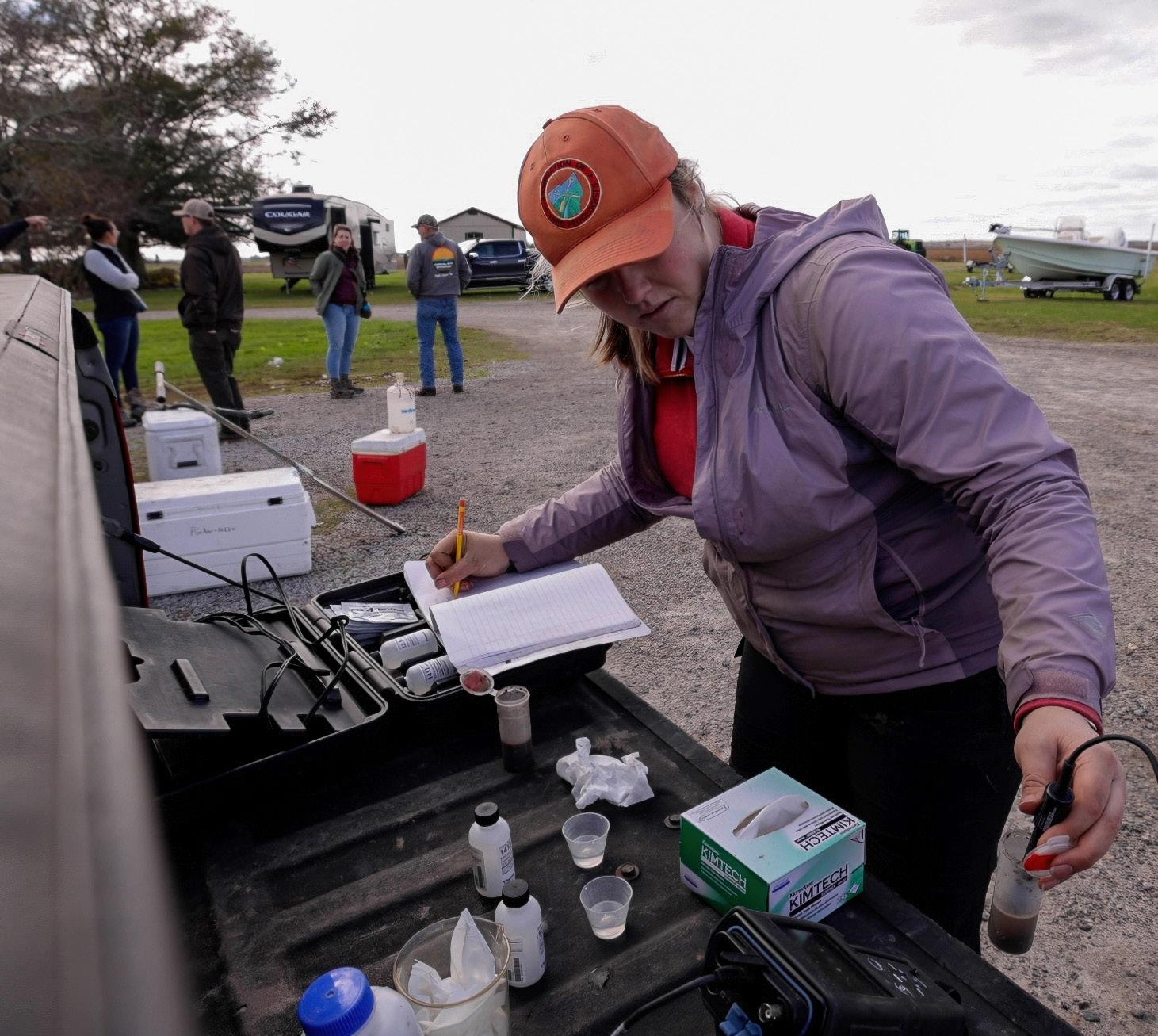
Climate change, he says, is forcing farmers to ask tough questions: Should they grow different crops, sell waterlogged land, transform portions into wetlands or move on from farming altogether? Their answers could alter the farming landscape in North Carolina’s coastal regions.
SAM JONESClimate change is forcing farmers to ask tough questions: Should they grow different crops, sell waterlogged land, transform portions into wetlands or move on from farming altogether?

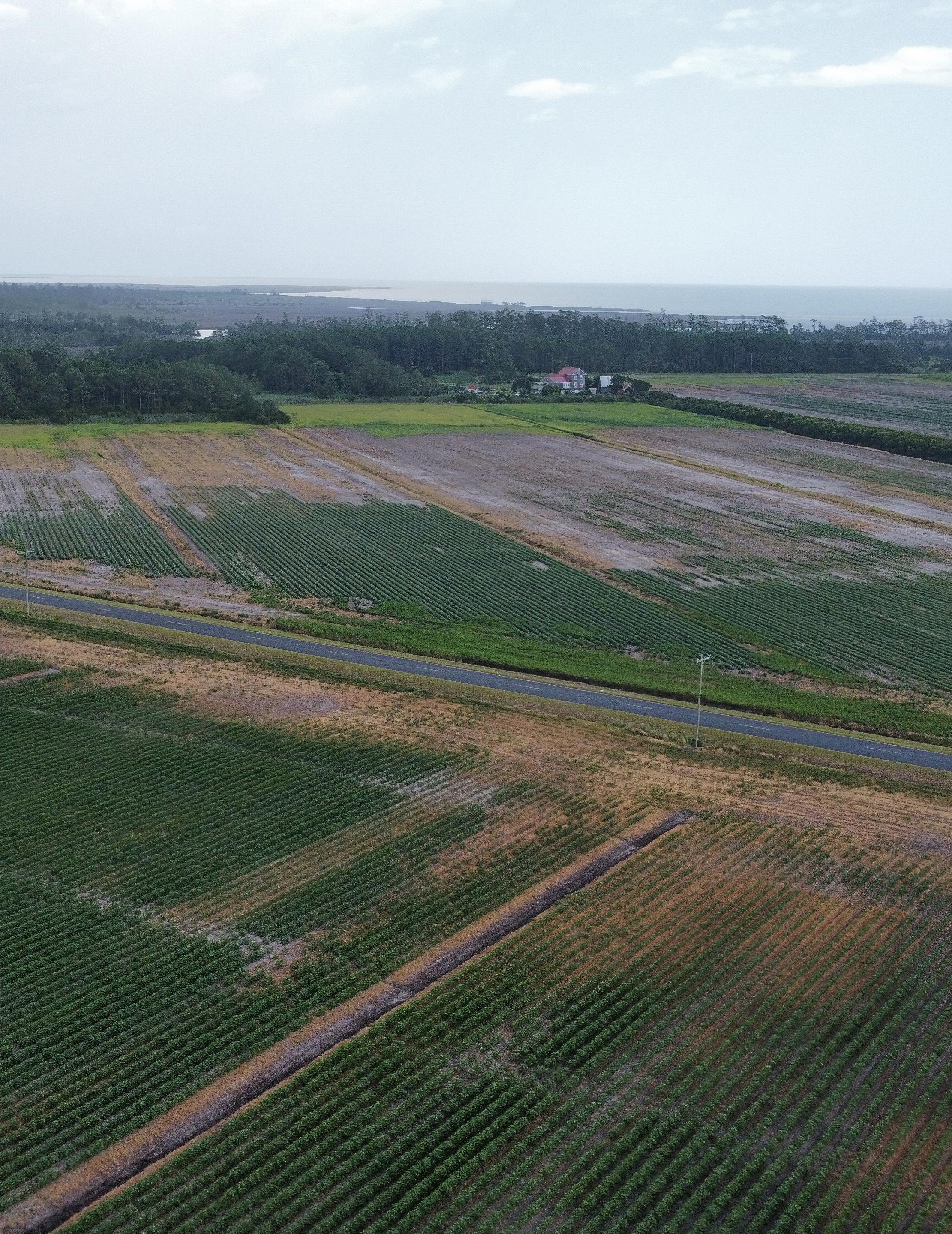
THE TRUE VALUE OF A LANDMARK FIELD LAB
 BY SAM JONES
BY SAM JONES
ust five miles from downtown Raleigh and the North Carolina State University campus sits the Lake Wheeler Road Field Laboratory, a productive and diverse teaching farm that drivers passing by could easily miss. This 1,784-acre swath of farmland is actually one of the largest remaining open spaces near the city. >
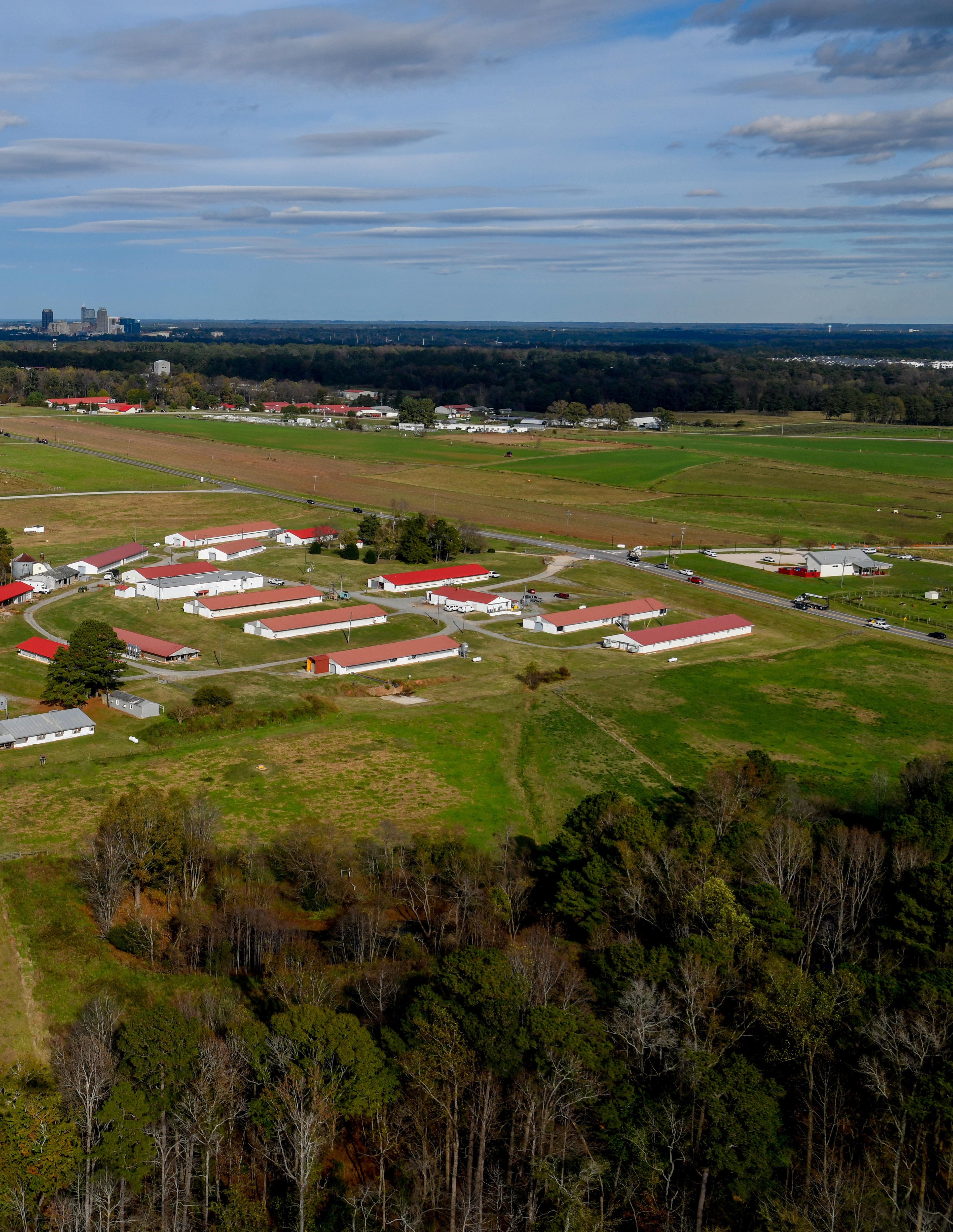 PHOTO ESSAYS BY ALICE MANNING TOUCHETTE
PHOTO ESSAYS BY ALICE MANNING TOUCHETTE
As cranes dot the city’s skyline and orange cones line its roadways, dump trucks move root and earth to make way for more people. The Raleigh metro area grew 23% from 2010 to 2019, and the state as a whole had the third-highest in-migration in the United States in 2021.
According to data provided by Georgina Sanchez at the NC State Center for Geospatial Analytics, developed land in North Carolina has increased by 24% over the past two decades while agricultural land has decreased by 6%. In Wake County, the changes are much more drastic: 16% of Wake County’s agricultural land has been lost since 2001 with an additional 21% projected to be lost by 2050. Indeed, N.C. Agriculture Commissioner Steve Troxler has highlighted the loss of farmland as one of the state’s biggest issues.
NC State and the North Carolina Department of Agriculture and Consumer Services own and operate thousands of acres across the state at 24 research stations, field labs and extension centers that act as conduits between university research and North Carolina’s agricultural community.
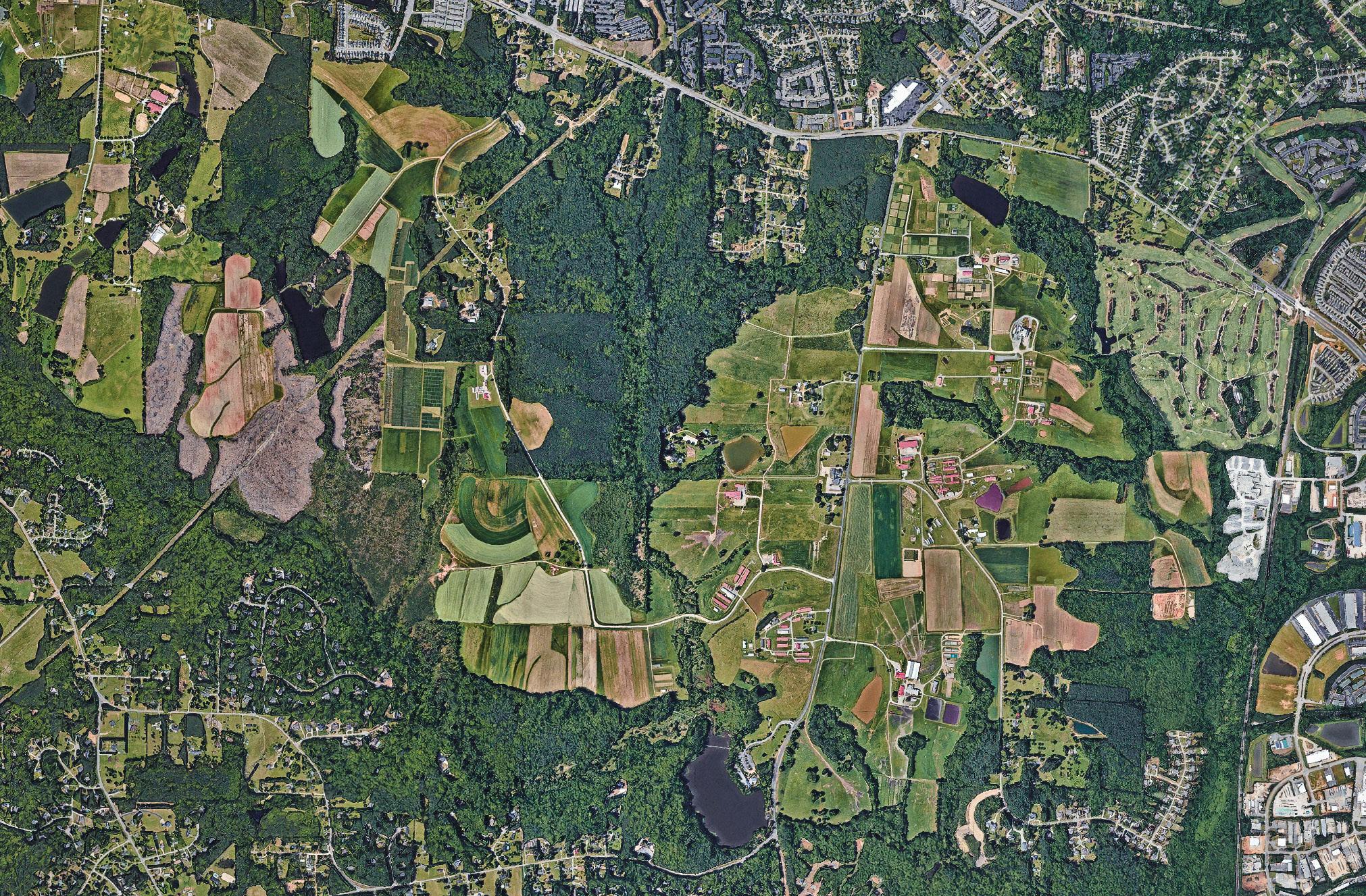
“It might look like empty fields to some people, but there is absolutely zero unused land at Lake Wheeler.”
Loren Fisher Director of Research Stations and Field Labs at NC StateAerial view of the 1,784 acres that make up the Lake Wheeler Road Field Lab.
The Lake Wheeler Road Field Lab is vital to NC State’s land-grant mission of teaching, research and extension. As developers look to acquire any available open land, protecting the Lake Wheeler farmland remains a top priority for NC State and the College of Agriculture and Life Sciences.
“Because of its proximity to Raleigh, I get inquiries from people every month about this land,” says Steve Lommel, director of the North Carolina Agricultural Research Service. “I used to only get a few every year, so it has definitely increased lately. But the bottom line is that Lake Wheeler is not for sale. This land is absolutely essential.”
Lake Wheeler is one of the most diverse university farms in the country, according to Bridget Lassiter, the field lab’s superintendent. With over 20 research units, the farm’s diversity mirrors North Carolina’s multibillion-dollar agriculture industry. It also sets NC State apart; few land-grant universities have a farm so close to an urban campus.
The field lab acts as an outdoor classroom, integrating plant and animal science with engineering, sustainability and resource economics. The animal science department alone teaches over 1,700 students there every semester. >
You may have heard of the farm-to-table movement, but for many of NC State’s dining halls, it’s farm to table to farm.
An average of 20,000 pounds of produce is grown each year at the Agroecology Education Farm. Here, students work closely with volunteers to cultivate one acre of land into indemand produce for 40 different dining locations on campus.
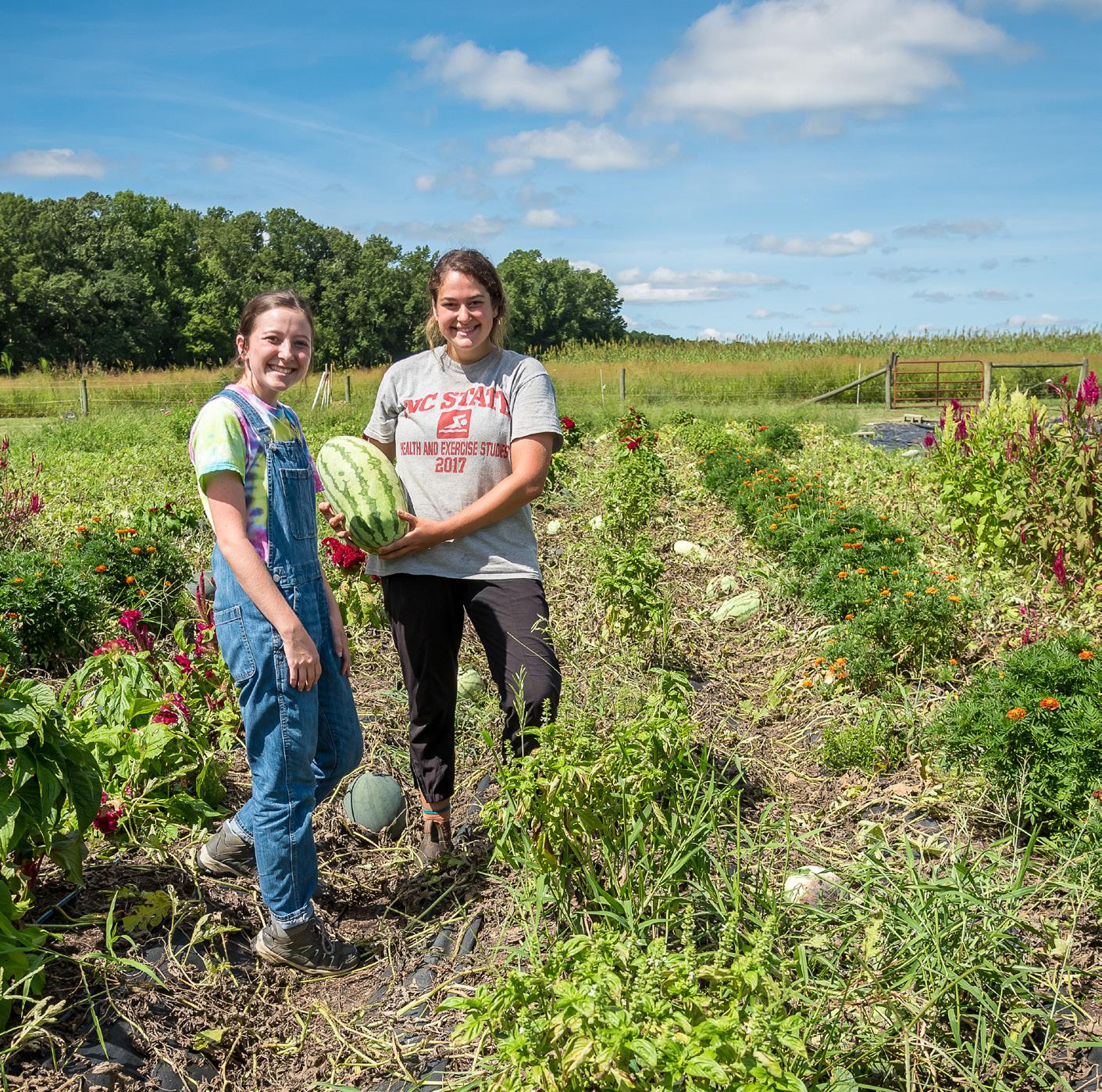
“The farm’s staff and volunteers work with NC State chefs to grow what they want: tomatoes, peppers, watermelon, summer squashes and cool-weather crops like greens, lettuces and root vegetables. The vegetables go to student dining halls, teaching kitchens and other locations on campus that need them.
In return, the dining facilities donate their food waste to the Lake Wheeler compost facility and research cooperative run by university Waste Reduction and Recycling.
That team works closely with the farm to create blends of compost materials that are specific to growing vegetables, especially those grown organically.
Using the compost is a win-win: The farm now enjoys increased yields and soil quality, while the dining service saves money it would otherwise have to spend to get rid of food waste.
“This land is absolutely essential.”
Steve Lommel Director, N.C. Agricultural Research Service
Birds of a feather flock to NC State’s Prestage Department of Poultry Science, one of only six poultry science departments in the United States. The department’s long history of supporting poultry farmers, students and the industry include research and development of new biosecurity measures for the birds at the Poultry Education Units at Lake Wheeler.
“NC State is home to some of the world’s top poultry and animal agriculture experts and facilities,” said John Dole, CALS interim dean. “We deliver excellence in teaching, research and extension to meet the industry’s needs and grow our state. The birds couldn’t be in better hands.”
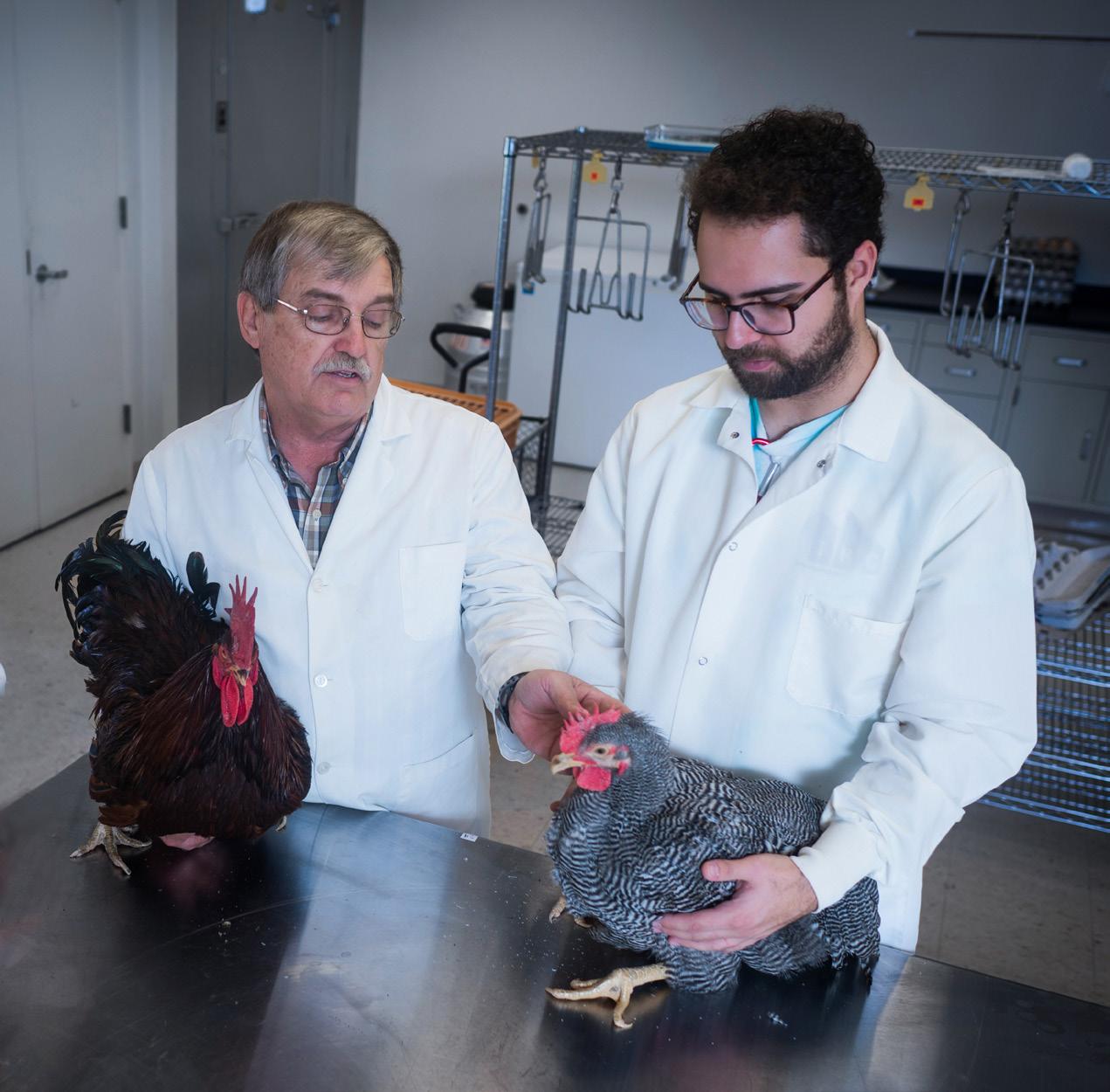

Current projects include research into poultry diseases and an investment to meet biosecurity level 2 requirements. In addition, construction of a biosecure mobile coop will make it possible to transport the turkeys and other birds for public viewing and educational outreach at events such as the North Carolina State Fair and the College of Agriculture and Life Sciences Farm Animal Days.
The field lab doesn’t just educate students. From the Sediment and Erosion Control Research Education Facility to the Pest Control Training Pavilion to countless training sessions on wastewater management, Lake Wheeler trains over 4,000 professionals every year. These professionals are essential for keeping North Carolinians and the environment safe and healthy.
Any open land that people might mistake for empty fields ripe for development is already taken up by hay, silage, grazing space and waste management areas for the field lab’s animals.
“It might look like empty fields to some people, but there is absolutely zero unused land at Lake Wheeler,” says Loren Fisher, director of research stations and field labs at NC State.
Lommel explains that if houses or office buildings were allowed to be developed on the farm, the site would be rendered non-compliant. As a result, for example, animal herds would need to be reduced or eliminated completely, diminishing NC State’s ability to provide animal research and teaching facilities for its students and faculty. >
The Lake Wheeler Road Field Lab will soon break ground on a $20 million investment for NC State’s Small Ruminant Unit, now housed along Trenton Road in Raleigh. The expansion and relocation to Lake Wheeler comes for a good reason.
“There’s great potential for a locally raised lamb and goat meat market,” says Andrew Weaver, NC State Extension specialist in small ruminants. “The United States produces less than half of the lamb that we consume in this country, with imports making up the deficit to meet demand. The potential for the domestic market is huge.”
Weaver’s research is directed toward improving production and management of small ruminants for meat production. One problem he’s helping to solve: parasites—one of the reasons sheep aren’t raised on a large scale in North Carolina.

“We want to learn and share how we combine genetic management with grazing practices, forages, feed for a systematic approach to parasites,” Weaver explains. “Combining multiple tools to combat parasites from different angles will ensure that the animals stay healthy and that production is sustainable.”
Weaver is also testing multispecies systems for livestock production— for example, adding sheep to existing cattle production systems.
“Land is not cheap, we’re stuck with what we’ve got, so we have to make it as productive as it can be,” says Weaver. “We can combine sheep and cattle … and not change anything about our production system. Then farmers will have a new set of animals generating income and make substantial improvements in profitability.”
“The fact is, we do teach thousands of students and professionals here. We do need that land for proper permitting of our facilities, and we need these facilities to train the next generation of farmers and ag students. We also do very important research here.”
Steve Lommel Director, N.C. Agricultural Research Service
Sitting on the porch at the Howling Cow Creamery, visitors take in a stunning view of the Lake Wheeler Road Field Lab property: rolling green hills, the famous Jersey cattle, red tin-roofed barns and the NC State dairy unit facilities.

“Good ice cream helps, but what really draws people in is this view from the Howling Cow Creamery,” says Alex Ives, dairy education coordinator at the Howling Cow Dairy Education Center and Creamery. “It’s an escape. People watch their kids play on the lawn and visit with friends. They’re drawn to the natural aspect of what we offer.”
The Dairy Education Center was the first field lab research farm to invite the public into its space. Beyond getting a tour of the facilities and meeting the cattle up close, groups take in the Randleigh Dairy Heritage Museum, a unique agritourism experience for children and adults to learn how milk gets from the farm to the table—and into Howling Cow ice cream.
It started when William Rand Kenan Jr. bequeathed his herd of Jersey cows to the University of North Carolina system in 1965. Their family helped create the NC State Dairy Farm, and the cows roaming the fields are descendants of that original herd.
“The 150 cows we milk are vertically integrated. That means we are growing the crops for our cows, feeding and milking them. Then we process the raw milk through pasteurization and homogenization into milk products that our students on campus are drinking and into our ice cream products,” says Ives. “It’s what we call in the dairy industry a value-added venture, and it’s a clear illustration of how the Dairy Education Unit falls into our mission of teaching, research and extension.”
Up next for the Dairy Education Center: a new research project on agritourism, an expansion of the museum, and new flavors of ice cream—all in an effort to expand CALS’ mission to extend agricultural education to the public.

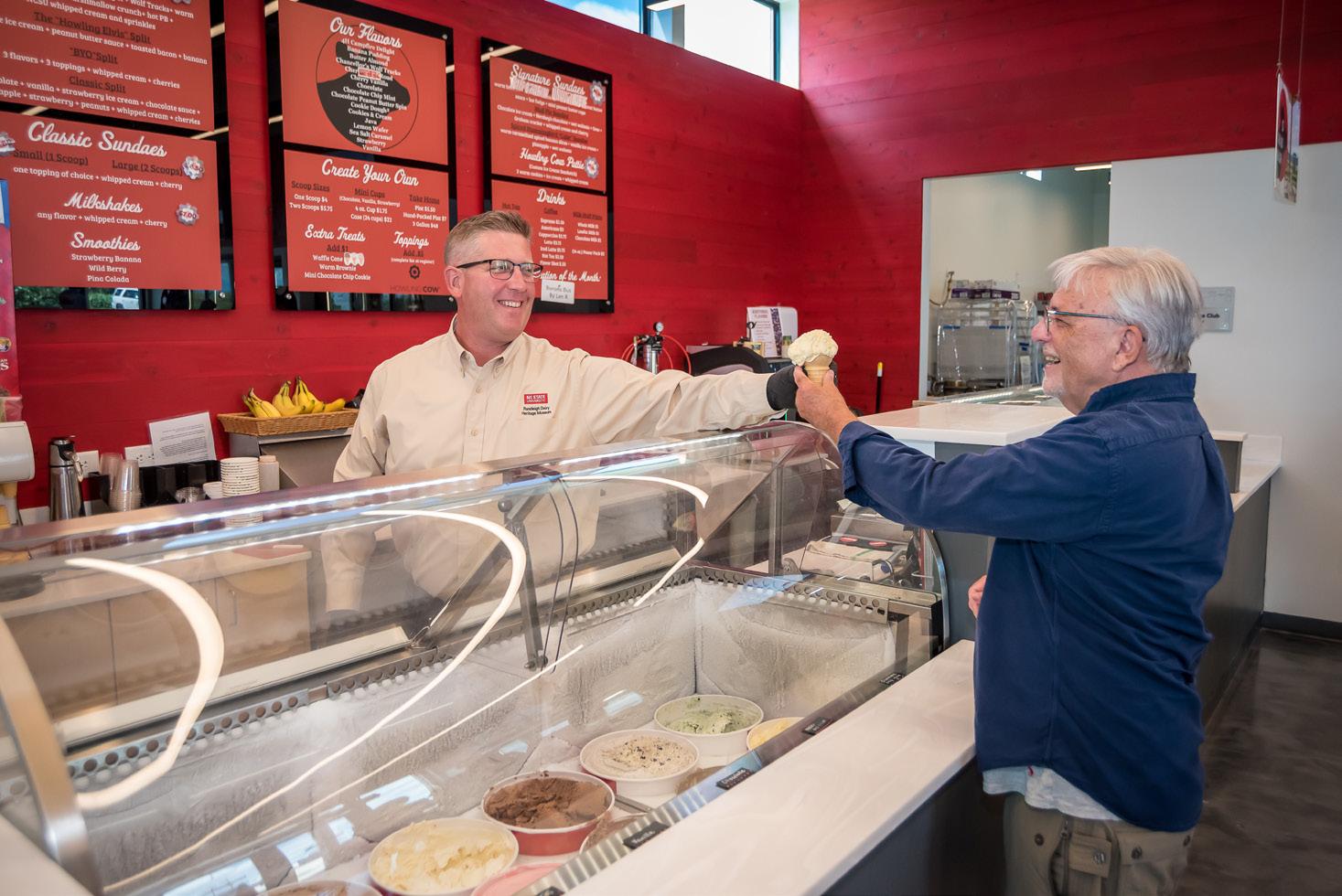
“The fact is, we do teach thousands of students and professionals here. We need that land for proper permitting of our facilities, and we need these facilities to train the next generation of farmers and ag students,” says Lommel. “We also do very important research here.”
With a finite amount of land available for field research so close to campus, researchers at the field lab are innovating ways to think and do more with what they have. A $1.2 million fiber internet building expected to be completed in May will truly bring the field lab into the future by spurring smarter agriculture through advanced data collection and analysis.
On top of the teaching and research mission, the field lab is becoming an agritourism destination. Over 10,000 people from across the state attend the Farm Animal Days event every year. The Howling Cow Dairy Education Center and Creamery, the first retail store on a university farm in the country, welcomes over 3,000 visitors monthly. Howling Cow ice cream is made and sold by NC State students, while the cows are milked and cared for by animal science students who live right on the farm.
So it’s not just the physical 1,784 acres that provide North Carolina and NC State with so much value. As Lommel notes, thousands of students—the future farmers, industry leaders and climate specialists—benefit from this land by gaining the necessary skills to address our most pressing challenges. Lake Wheeler’s true value rests in the future of the food system, our ability to solve problems and generations of changemakers.
Annually, on the second Wednesday in August, some 750 people gather at the 24-acre Lake Wheeler Road Turfgrass Field Lab for the largest turfgrass field day in the country. Turf managers and researchers gather to hear from NC State researchers nationally and internationally known to be experts in their field. One of them is self-proclaimed mother of turfgrasses Susana Milla-Lewis, professor in turfgrass breeding and genetics in the Department of Crop and Soil Sciences.
Her children so far: Sola™ St. Augustinegrass, released at the August 2022 field day by the turfgrass breeding and genetics program after 11 years of evaluation and development, and Lobo™ Zoysiagrass, released in November 2021. These new cultivars from Milla-Lewis’s breeding program ensure that turfgrass stands are dense, use less water, outcompete weeds, are quick to establish and can survive across different climates throughout the state and country.
Nationally, the turfgrass industry covers 50 million acres in the United States. That may sound like a lot, but it starts sounding about right when you consider that the United States has over 700,000 athletic fields, over 80 million home lawns, more than 17,000 golf courses and millions of miles of roadsides.
Here in North Carolina, turfgrass is grown on over 2 million acres, more than any other crop in the state. For those who want to learn how best to grow and manage it, there’s no better program than the NC State Turfgrass Management Program and no better place to research and evaluate it than the Turfgrass Field Lab.

Established before the American Revolution, Yates Mill is one of the most photographed and painted landmarks in the state and the only remaining gristmill still in operation in Wake County. Lovingly and passionately restored by head miller William Robbins over five years, it is an astounding example of engineering, history and renewable power that represents the agricultural heritage of North Carolina from the 1700s and 1800s.


Yates Mill sits on a 174-acre wildlife refuge owned by NC State and managed by Wake County Parks, Recreation and Open Space. The 20-acre mill pond is fed by Steep Hill Creek and a 3,300-acre watershed. The property serves as a field research lab for students and faculty and soon will include a new freshwater mussel research
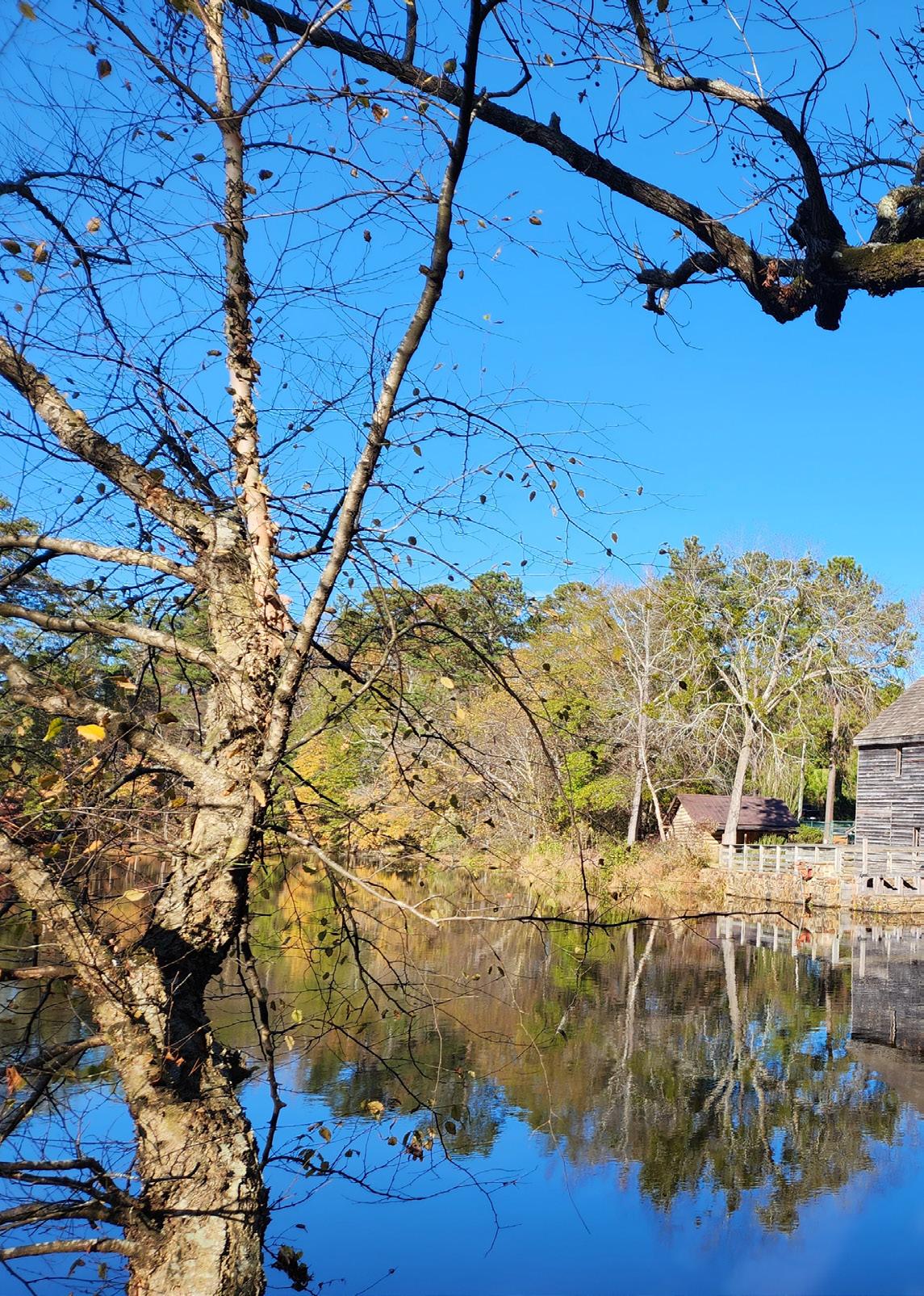
research efforts on the freshwater pond will examine toxicological effects of waterborne and sediment-associated contaminants on fish and
Yates Mill and the land that surrounds it stand as reminders that preserving our agricultural heritage and conserving our natural resources go hand-in-hand with forging new agricultural practices. They inform each other and demonstrate the ingenuity, simplicity and creativity required in the ongoing work to create sustainable practices that feed communities.
Discover what it took to restore the historic mill to working condition in an exclusive online CALS Magazine feature.
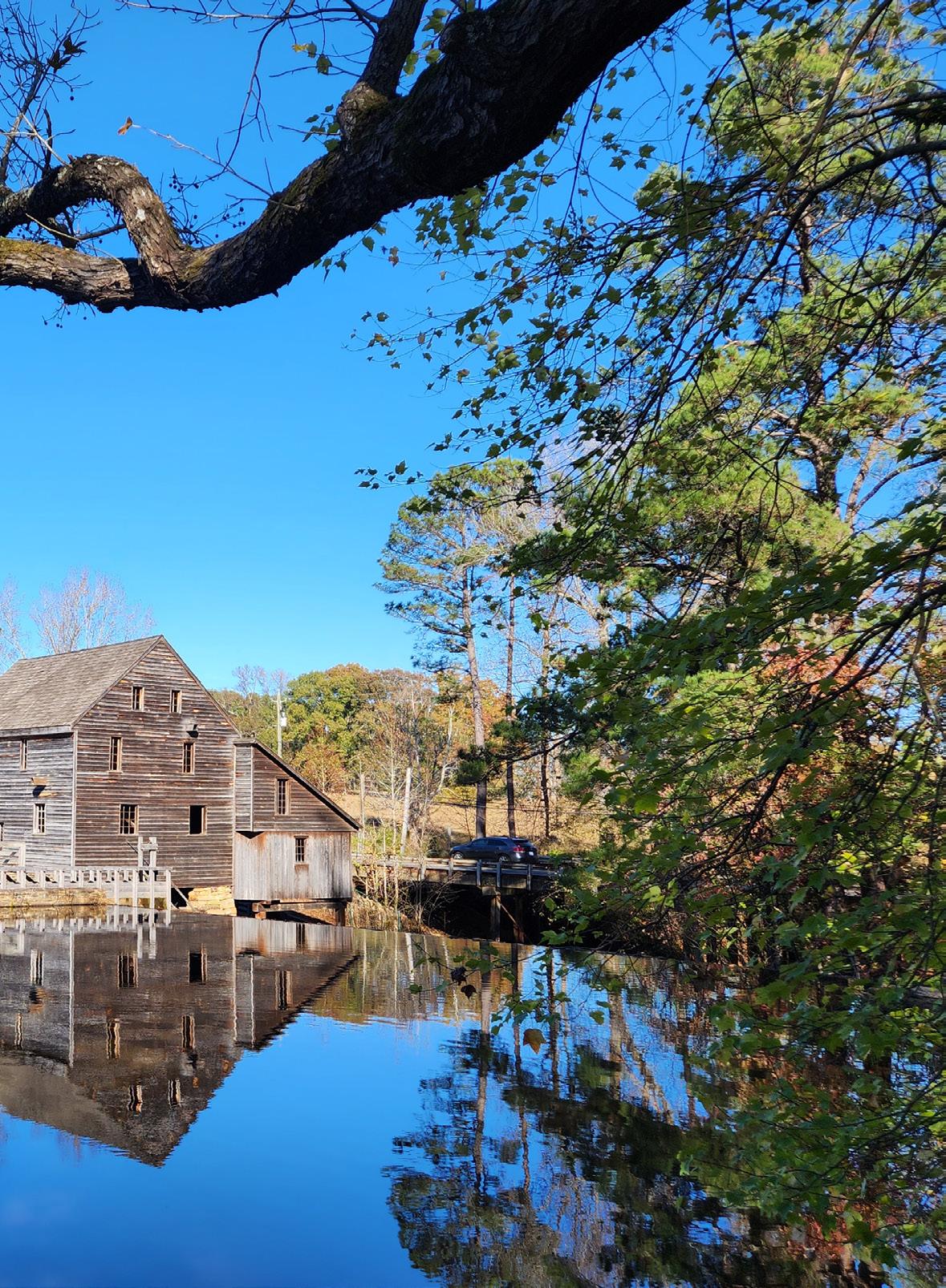
Units at Lake Wheeler Road Field Lab
> Agroecology Education Farm
> Air Quality-Plant Growth and Development Unit (U.S. Department of Agriculture Agricultural Research Service)
> Animal Air Quality and Environmental Management Field Laboratory
> Animal and Poultry Teaching Unit
> Animal and Poultry Waste Management Center and Processing Facility
> Animal Health Building
> Aquaculture Education Unit
> Bee Research Facility
> Chicken Education Unit
> Compost Facility and Research Cooperative
> Compost Learning Lab
> Dairy Education Unit
> E. Carroll Joyner Beef Education Unit
> Feed Mill Education Unit
> Fike Crop Teaching Garden
> JC Raulston Arboretum Research Farm
> J. Edward Booth Field Learning Lab
> Sediment and Erosion Control Research and Education Facility
> Small Grains Research Area (USDA ARS)
> Structural Pest Training Facility
> Swine Education Unit
> Talley Turkey Education Unit
> Turfgrass Field Laboratory
> Weed Science Teaching Field Lab
Animal welfare has been a hot topic for years, and it’s something Bhavisha Gulabrai is passionate about. As a graduate student in the Prestage Department of Poultry Science, she’s preparing herself to become an authority on the subject, educating outsiders about the realities of animal agriculture.
“My passion for animal welfare really stems from people’s negative perceptions of the animal agriculture industry. Through experience with livestock and poultry, I can understand why people who have never set foot on a farm don’t understand why farmers do the things they do,” Gulabrai says.
The Rocky Mount native always enjoyed taking care of animals and found a love for animal agriculture as a freshman in animal science at North Carolina State University and through internships. Gulabrai interned twice with Braswell Family Farms, a fourth-generation family-owned company that produces and markets eggs and livestock feed to families and businesses.
“I knew I wanted a career working with and helping animals, but I had only ever been exposed to the veterinary aspect of things. These internships introduced me to animal agriculture and to my passion,” Gulabrai says.
Gulabrai came to appreciate animal agriculture’s importance as a steady source of income for North Carolina. In fact, according to the 2020 National Agricultural Statistics Service, over 65% of state cash receipts from agriculture come from livestock, dairy and poultry producers.
Much of Gulabrai’s first internship focused on feed and nutrition for the animals, testing nutrient content and overseeing the feedmill operation. Her second internship focused on live production, quality assurance and monitoring overall bird health— including well-being.
As she pursues a master’s degree under Aaron Kiess, Braswell Distinguished Professor and poultry Extension specialist, Gulabrai is creating her own research project.
“I’m interested in doing a layer welfare study, basically measuring stress and behavioral parameters among different strains in cage-free environments to see how their welfare differs,” says Gulabrai.
Kiess sees a lot of promise in the graduate student.
“There’s still a lot of work to be accomplished, but if Bhavisha continues to exceed expectations like she has thus far, the end results will have real impact for the layer industry,” Kiess says.
Due to consumer demands, public perception and legislation like California’s Proposition 12, the Farm Animal Confinement Initiative, the commercial egg industry is shifting more toward cage-free production. Prop 12 was passed in 2018 and requires that covered animals be housed in confinement systems that comply with specific minimum standards for freedom of movement, cage-free design and minimum floor space. Gulabrai says there’s not much that can stop this shift, but welfare still needs to be measured in these types of environments.

“I think it’s important for consumers to know that no production environment is going to be perfect,” says Gulabrai. “Genetic selection and management strategies are implemented in order to try to create the most optimal environment for these laying hens. However, just because cage-free environments have a more positive connotation, it doesn’t mean more work can’t be done in order to improve the well-being of the various strains that are put into these environments.”
Not having come from an agricultural background, Gulabrai has had to educate herself about the animal agriculture industry and form her own opinions about the industry and its practices based on what she’s seen and experienced firsthand.
“Anyone who knows me knows I love animals more than people,” Gulabrai says. “I would never be OK with animal cruelty or support an industry that is OK with that.”


“I would never be OK with animal cruelty or support an industry that is OK with that.”
As major companies pledge support for regenerative agriculture, consumers and growers have important questions. For starters, what exactly is it? And can it play a role in North Carolina agriculture’s future?
BY JENNIFER HOWARDRegenerative agriculture: It’s a buzzword that’s easy to sell but hard to define.
Regenerative agriculture’s professed goal is to use the soil and environmental ecosystem—rather than conventional fertilizers and tillage—to power farm productivity, reducing off-farm inputs, mitigating climate impacts and improving biodiversity and habitats.
It’s billed as a solution for global food security, the climate crisis and environmental preservation—basically, why we could press pause on Occupy Mars. But these promises are a tall order.
Regenerative agriculture surfaced as a grassroots movement centered in the Midwest during the 1990s as climate debates intensified. The concept is based on the soil improvement practices of self-sufficient, pre-World War II farms. The emphasis is on using soil biology, rather than synthetic fertilizers, to power crop growth.
Definitions of regenerative agriculture vary, but the core principles are outlined in the graphic to the right.
What do these principles look like on the farm?
> crop rotation
> cover cropping, ideally with multiple plant species
> no- or low-till systems
> soil management to support soil’s chemical, biological and physical properties
> rotational livestock grazing
While many of these individual practices are commonplace in North Carolina, the combination is not. And while there’s general agreement on the intrinsic value of productive soils, the amount of regenerative practices required to merit the title is unclear.
Regenerative agriculture’s proponents tout its benefits to farmers (input savings and crop productivity) and the environment (reduced greenhouse gas emissions). They also point to its place in emerging carbon markets, in which companies wanting to offset their carbon emissions pay farmers to capture and sequester carbon in their soil.
The trouble is, it’s tricky to define universal guidelines when the farms where regenerative agriculture could take root vary so greatly in size, soil type and crops produced.
While some think of regenerative agriculture as a fringe movement, major corporations have pledged enormous resources to support regenerative growers. General Mills, Cargill, PepsiCo, Walmart and others have adopted regenerative agriculture as a matter of corporate responsibility and integrated the term into their marketing. Forbes called it the “next trend in food retailing.”
The 2022 United Nations Climate Change Conference included a session on regenerative agriculture, and a movement is afoot to include regenerative agriculture in the 2023 U.S. Farm Bill.
But the term’s ambiguity and lack of evidence-based research make the regenerative agriculture tag a big maybe with some farmers.
“That’s one of our problems—too many labels,” says Davon Goodwin, a first-generation farmer growing grapes on 42 acres in Laurinburg, North Carolina. “I don’t want to be put in a group.”
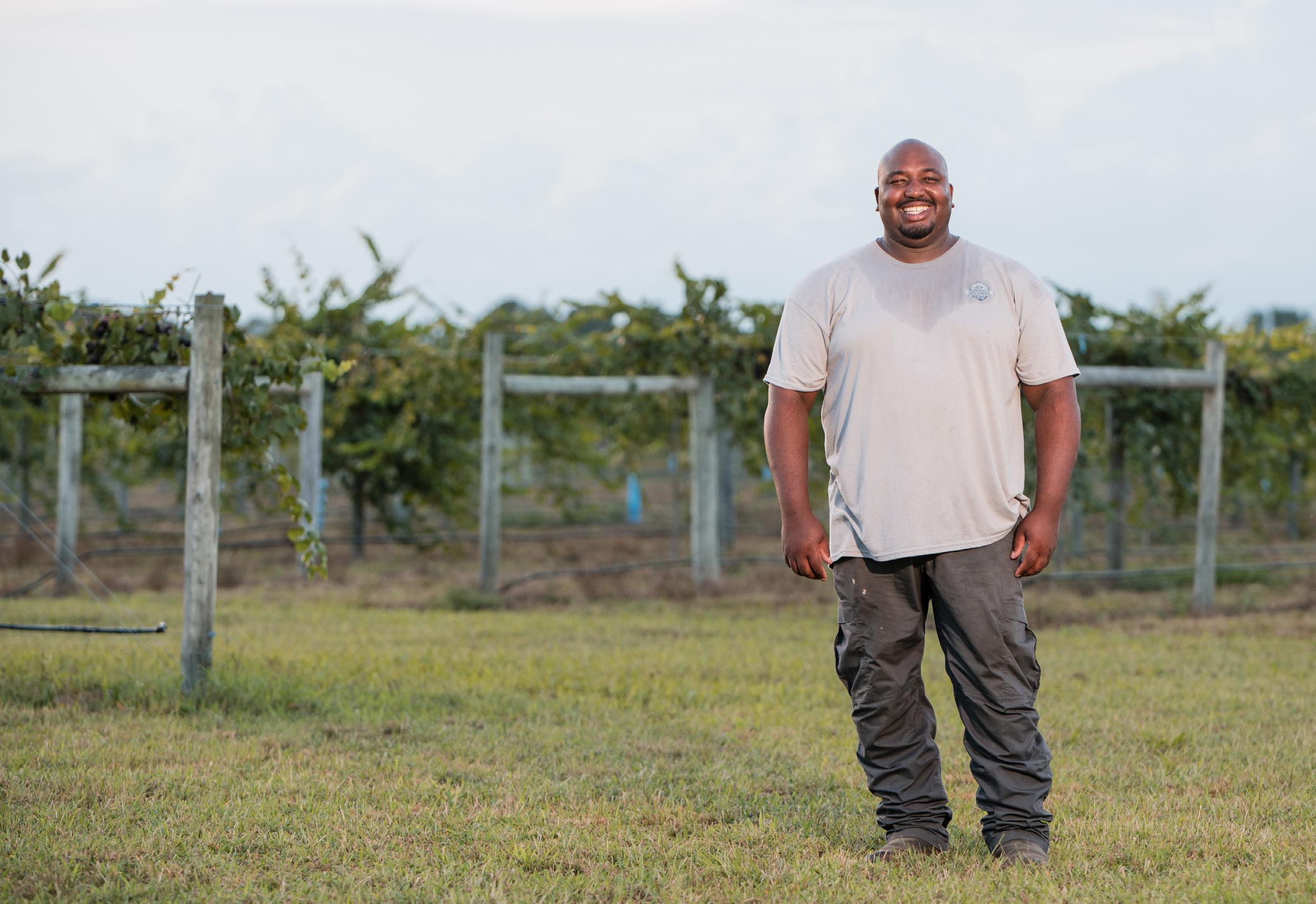
Indeed, there’s no shortage of labels. “Climate-smart.” “Sustainable.” “Renewable.” “Resilient.” But are these terms relevant, different or, more importantly, doable in North Carolina?
“We do a lot of regenerative practices on our farm, but everything is location-specific,” Goodwin says. “You can’t stand on the rich soils of the Midwest and tell me how to build carbon in my sand.”
For farmers statewide, North Carolina State University researchers are investigating and debating these ideas. >
“We do a lot of regenerative practices on our farm, but everything is locationspecific.”
Davon GoodwinFirst-generation farmer Davon Goodwin uses some regenerative practices in his 42-acre muscadine grape orchard near Laurinburg.
Through photosynthesis, plants take carbon dioxide (CO2) out of the atmosphere.
Animals and soil microbes create and release carbon dioxide back to the atmosphere.
Plants use the CO2 and water from the soil to build carbohydrates that make up roots, stems and leaves.

Organisms in soil feed on carbon released from roots and decomposing plant matter.
When roots or microbes die, they free carbon to enter the soil. Also, animals feeding on plants or other animals defecate and die, allowing carbon to cycle back into the soil.
In any conversation on climate and soil health, carbon is the headliner. That’s because soil has the ability to pull carbon out of the atmosphere and store it within a network of organisms where carbon can support living things.

Storing carbon underfoot isn’t straightforward. Microbes and other soil life can gobble up carbon in a process that accelerates as temperature rises.
Soil management practices like cover cropping to boost soil carbon produce different results depending on the soil type, structure and climate.
For North Carolina farmers, it’s not a cut-and-paste from the post-glacial soils of Illinois.
As NC State soil scientist Deanna Osmond says, “The genetic potential of North Carolina’s soils to sequester carbon is totally different than the Midwest. Their mineralogy, texture and freeze-thaw cycle is unlike here, where our soils never stop respiration. We churn (through) carbon almost year-round.”
NC State agroecology expert Michelle Schroeder-Moreno, director of the Center for Environmental Farming Systems (CEFS), explains that four things speed up organic decomposition: moisture, heat, carbon-to-nitrogen ratio and oxygen.
“Most of our North Carolina soils have low organic matter,” says Schroeder-Moreno, who holds the W.K. Kellogg / Blue Cross and Blue Shield of North Carolina Foundation Endowed Distinguished Chair in Sustainable Community-Based Food Systems. “The Blacklands soils of eastern North Carolina are only rich in organic matter because they were underwater—anaerobic—for millennia.”
“The hot, humid conditions in North Carolina speed up organic matter decomposition in the majority of our soils. When we add tillage and other agricultural practices that bury organic matter or don’t perform practices that add organic matter, such as leaving previous crop or cover crop residues, it’s a zero-sum game. We are speeding up organic matter loss to an even greater extent in agriculture in North Carolina.”
Growers understand the benefits of adding organic matter to the soil to build carbon.
Gary Hendrix farms almost 8,000 acres of rotating crops in the Sandhills of Raeford. “Organic matter softens the land,” he says. “We strip-till and cover crop, especially to improve marginal land. Increasing organic matter has increased yield on our best soils and made others (produce more consistently) each year.”
His primary interest in carbon is less about longterm sequestration than soil moisture retention.
“I tell folks that we’re always three days from a drought and trying to stretch it to five.” Leaving organic matter or plant residue from a crop on the soil surface is the key to resilience in Hendrix’s operation. “It doesn’t matter what you call it; I like to plant in trash.”
Hendrix’s practices check at least three of regenerative agriculture’s boxes: strip-tilling, planting cover crops and managing soil diversity. Is that enough for him to call regenerative “bingo!” and benefit somehow?
As interest in regenerative agriculture, climate markets and incentive programs evolve, NC State is knee-deep in research and extension education.
“In North Carolina, we’ve been encouraging conservation tillage for 50 years. It’s not new,” says Osmond. “Some of our research plots have been testing tillage practices for that long. And there’s no choice on crop rotation here. There’s too much disease pressure not to.”
Today, sustainable agriculture studies in cover crops, climate adaptation and grazing management leapfrog across disciplines at NC State. For example, crop science graduate student Matthew Starr studies amino acid-based biostimulants—a way of feeding the soil microbiome to encourage nutrient cycling. He is researching seed treatments and soil-applied biostimulants to improve plant resiliency and cotton lint quality. >

“It doesn’t matter what you call it; I like to plant in trash.”
Gary HendrixGary Hendrix uses strip-tilling and cover crops to improve yields on his large farm in North Carolina’s Sandhills.
“We’re at a point of change, and I think that regenerative practices are the spearpoint,” Starr says. “Increasing soil biodiversity positively impacts soil function for crop productivity, environmental quality and, most importantly, yield.”
Asked if these approaches are practical for any grower, Starr says, “I think regenerative agriculture should be seen as a diverse set of tools a farmer can use. Biostimulants are one of the most immediately accessible practices because they don’t require new equipment nor special training—just forward thinking.”
Another tool farmers can use: cover crops, which prevent soil erosion and nutrient loss to the elements between plantings. Only 12% of North Carolina farms use them. Why not more?

As NC State sustainable ag researcher Chris Reberg-Horton explains, “There’s a frustrating lack of simple answers in cover crop use. An infinite number of variables affect performance.”
To help growers make sense of those variables, Reberg-Horton’s Precision Sustainable Agriculture Network is plugging away at web-based decision tools for cover crop species selection, weed control, nitrogen management and even
“We’re at a point of change, and I think that regenerative practices are the spearpoint.”
Matthew Starr
Graduate student
Matthew Starr studies biostimulants to encourage nutrient cycling in soils.
quantifiable soil carbon storage and greenhouse gas emissions.
He’s betting on artificial intelligence’s ability to provide practical value to farms. Researchers are working with remote sensing software to map the amount of nitrogen produced at every point in a field to guide fertilizer application in real time.
NC State’s Climate Adaptation through Agriculture and Soil Management group (CASM) is tackling these issues with an interdisciplinary approach. The group is investigating multiple avenues with an eye to farm productivity and profitability.
CASM soils researcher Alex Woodley, for example, is evaluating enhanced efficiency fertilizers’ (EEFs’) ability to reduce farm costs and environmental impact while generating financial incentives.
“Nitrogen fertilizers are one of the most energy-intensive inputs on a farm,” Woodley says. “Improving nitrogen use efficiency and reducing nitrogen inputs with EEFs could significantly lower the global energy footprint of agriculture, and in the future potentially open a new revenue stream for North Carolina farmers through reduced greenhouse gas emission payments in the carbon market.”
Meanwhile, Matt Poore of NC State Extension’s Amazing Grazing program hosts adaptive grazing management training that emphasizes location-specific grazing practices. He’s a strong advocate of the value of using livestock to speed up nutrient cycling.
“Every grower wants to increase soil organic matter. But residual plant nutrients are locked in fiber,” Poore says. “Grazing animals can break that into simpler forms and smaller particle sizes to stimulate the biological system. >
< Photo taken just under two months after planting. The plant on the left received two biostimulant applications; the plant on the right is from the control field. Both plants looked similar above ground. Photo by Matthew Starr.

“There’s a frustrating lack of simple answers in cover crop use. An infinite number of variables affect performance.”
Chris Reberg-Horton
“They have the ability to degrade and cycle carbon through pasture ecology.”
Still, if integrating livestock is required to merit the regenerative agriculture label, it may be a hard stop for some producers. North Carolina farmers may have row crops, livestock or both, but rarely do livestock forage on large-scale cropland.
The logistics of fencing and watering animals are a challenge for large-scale farmers, and grazing on small-acreage specialty crops can be impractical.
While there is a thriving community of small-scale producers who embrace integrated livestock systems, a lack of familiarity and infrastructure for animals are common barriers for larger-scale farmers.
Forage extension specialist Miguel Castillo helps producers with livestock logistics through a vast on-farm climate-smart grazing project. He and his colleagues with extension programs in eight other states will train and pay livestock pasture managers a total of $12.2 million to adopt and document proven climate-smart management practices.
An earlier Sustainable Agriculture Research and Education-funded project investigated the potential to raise fast-growing stocker cattle that graze on cover crops. As an NC State animal science Ph.D. student, Jordan Cox-O’Neill evaluated the effects on the land and livestock from grazing winter cover crop mixes.
“Although it was a short study, we saw a tendency of greater yield and no difference in soil compaction from the grazed and non-grazed fields,” Cox-O’Neill says. One farmer who used no-till planting techniques for his soybean crop after winter grazing harvested a record crop of 80 bushels per acre.
The project was so successful that CoxO’Neill decided to continue grazing 120 to 210 calves on leased land. Despite the logistics of portable fencing and watering, it’s been profitable enough for both her and the farmers to continue.
“It’s been a great relationship, but there does have to be a great deal of communication around planting and harvest. But the idea is growing,” Cox-O’Neill says.
“I’ve seen a dozen or more producers in the area contract grazing cropland since our project.”
Regenerative agriculture’s future in North Carolina will depend on whether it can deliver promised benefits in an affordable way. Debate may occur online, but action happens in the field.
Schroeder-Moreno, who focuses on sustainable farming practices, says that debates about the precise definition of regenerative agriculture are important to the research community but may delay or lead to missed opportunities for farmers to implement good production practices.
“Within CEFS we have been researching sustainable agriculture practices for close to 30 years, with many of those now considered to fall under regenerative agriculture practices,” she says. “We know cover crops, crop and animal rotations, reduced tillage and practices that add perennials can increase diversity, organic matter and other agricultural benefits for North Carolina farmers.
“The priority should be to focus on these good practices and bring more people to the table of sustainability.”
Cox-O’Neill, the Ph.D. graduate who conducted grazing research, sees regenerative agriculture as giving farmers new options.
“The priority should be to focus on these good practices and bring more people to the table of sustainability.”
Michelle Schroeder-Moreno
“I’m a big believer in using regenerative agriculture practices,” she says. “In some cases, they are very cost-effective and you get good production from them, but they don’t always fit. I try to match a blend of commercial agriculture and regenerative practices when they fit the situation.”
Hendrix says that no matter how it’s defined, marketed or incentivized, regenerative agriculture won’t be adopted at a larger scale without sound science and small business buy-in. Practices such as cover cropping, like everything else on the farm, have to pay off on the balance sheet, he says.
“We want to leave the land better than we found it, but we base our decisions on science and economics.”
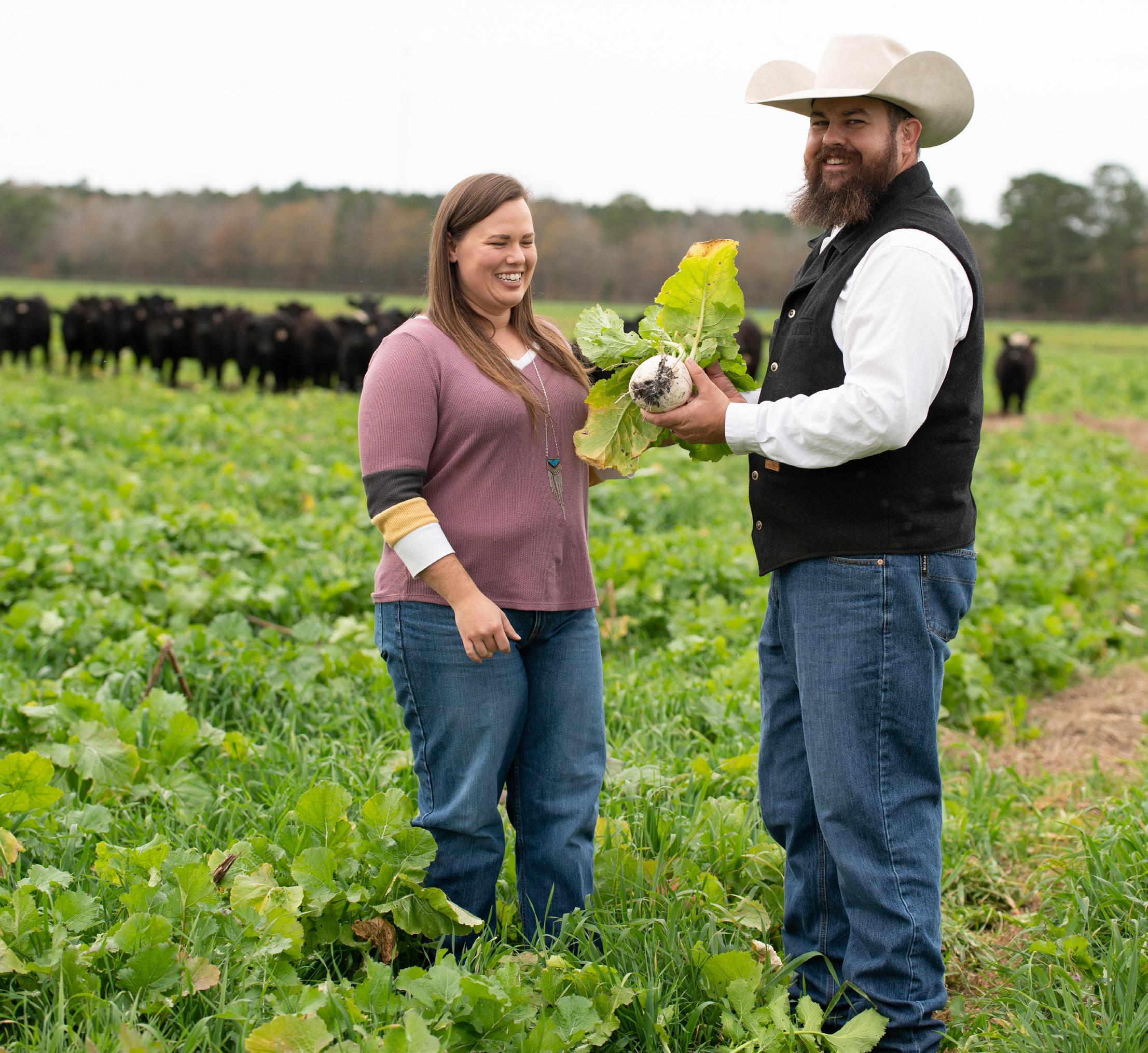
“The idea is growing. I’ve seen a dozen or more producers in the area contract grazing cropland since our project.”
Jordan Cox-O’NeillJordan L. Cox-O’Neill and Dustin O’Neill holding a purple top turnip, planted in a pasture with oats and cereal rye.
People, programs and innovation take center stage in the College of Agriculture and Life Sciences’ new strategic plan, “Growing Our Future.” Created by a team of over 30 faculty and staff members, the plan sets 10 priorities for ensuring the college’s success over the next seven years.
CALS’ previous strategic plan, “Our Envisioned Future,” spurred significant progress between 2013 and 2022. Before former Dean Richard Linton departed in early 2022 to become president of Kansas State University, he set the bar even higher, calling for a plan to make CALS the best land-grant college in the country and the best place to learn and work.
These initiatives will help fill a need and impact the industry directly, creating a stronger and more capable career-ready workforce for the world of agriculture.
Lisa Prince Executive Director, North Carolina Egg AssociationInterim Dean John Dole and Assistant Dean for Human Resources Rebecca Zuvich served as committee cochairs. The committee designed the plan to dovetail with Wolfpack 2030: Powering the Extraordinary, North Carolina State University’s latest strategic plan. Surveys, focus groups and interviews tapped the insight of thousands of CALS stakeholders in industry, government and academia.
Soon after the plan’s completion, CALS’ administration began assessing related personnel and funding needs. Dole said the college’s next dean will have the opportunity to make a big impact on the college through the plan.
John Garner“To be successful, we need to increase the level of support we get every year,” Dole said. “We have many innovative initiatives as well as facilities that need to be evaluated and upgraded.”
Dole believes one of the plan’s strengths is its emphasis on problem-solving interdisciplinary initiatives across research, academics and extension. The plan also calls for increased internal and external
Regardless of your role in the college, you can see yourself contributing to the greater good.
Rebecca Zuvich Assistant Dean For CALS Human ResourcesHopefully the plan reminds employees they are part of a much bigger effort than just what they do from 8 to 5.
Superintendent, Castle Hayne Horticultural Crops Research Station
communications, more progress in diversifying the college community and additional programs to ensure faculty, staff and student well-being.
This is only the beginning. Climate change, food and nutrition security, infectious diseases and water and soil preservation are all global problems that need to be solved collaboratively, and the new strategic plan provides CALS the opportunity to help tackle them all.
Jose Cisneros Director, CALS International ProgramsThe CALS plan emphasizes sustainability through the lens of the United Nations’ Sustainable Development Goals. These 17 goals address such broad topics as poverty, inequity, hunger, education, the environment and health and well-being. “In concert with these goals, the college wants to ensure the long-term viability of the industries with whom it partners,” Dole added.
College departments and units have been encouraged to set program goals that build on CALS’ plan.
“We are going to rely on departments and units to guide the specific topics we focus on,” Dole said. “As a committee, we focused on creating an efficient and connected CALS— one with a robust infrastructure to support the college’s people, programs and innovation. In the end, everything revolves around people.”
The plan is peoplecentered because that’s what our college is all about—the business of people.
AlyssaDeGreenia,
Learn what others are saying about CALS’ new strategic plan by visiting us online at go.ncsu.edu/CALSMagazine
Assistant Director, AgriculturalInstitute
Discontent with the status quo, NC State University’s Terri Long, Marvin Moncada and Kenny Sherin are creating life- and industry-altering change.
As NC State Extension’s first broadband access coordinator, Sherin is finding resources to bridge the divide between the digital haves and have-nots.
As a gene-discovering life science expert, Long is inspiring students to break barriers and shatter stereotypes on their way to becoming plant scientists.
And as a food scientist who’s helped develop over 50 grocery store products, Moncada is out to transform a centuries-old beverage industry at a breakneck pace.
Kenny Sherin is a fixer. Not in the sense of making problems go away, but in the literal meaning of, well, fixing things. It comes from his background of growing up on a small family farm.
“I have a knack for seeing these random pieces of stuff laying around and knowing what to do with them,” he said. “On a farm, you’ll have an old carburetor or a broken piece of equipment. That’s your parts supply store. If something breaks, you go to the old piece of equipment and use it to make repairs. I grew up watching my dad fix anything that was broken just by the parts he had available.”
That background suits him well as NC State Extension’s broadband access and education coordinator. The digital landscape is strewn with opportunities and challenges. Matching issues with resources takes someone with an experienced eye and a penchant for problem-solving.
“My vision is to help North Carolina residents earn, learn and be well using digital resources,” he said. “The National Skills Coalition just released a study stating 92% of jobs now require some type of digital skill. Digital skills education is workforce development.”
Education encompasses lessons in productivity tools such as accounting software, spreadsheets, online banking, photo editing, email marketing, website building and even advanced skills like coding and cybersecurity. It also includes exciting technology such as monitoring moisture meters in grain storage facilities and using data from drones to track the health of crops.
Sherin, Randolph County’s Extension director, added broadband education to his duties in March 2021, about a year into COVID-imposed lockdowns. That’s not a coincidence. The pandemic forced many workers and students into a virtual world—and spotlighted how many areas of North Carolina lack access to broadband.
Expanding access to high speed internet is primarily the purview of the North Carolina Division of Broadband and Digital Equity. But while NC State, as Sherin puts it, “is not able to dig the ditches and put the cable in the ground,” it has a significant role.
“We are an educational institution,” he said. “We can help folks learn to use the technology available to them.”
With offices in all 100 counties of the state plus the Eastern Band of the Cherokee Indians, Extension is well positioned to help people navigate the challenges of access and education. NC State recently received a $1.33 million grant from the NC Department of Information Technology that will provide resources to teach digital skills at a county level.
“It’s right in the wheelhouse of Cooperative Extension to be doing this,” Sherin said. “Extension has always been there to help society adjust to new changes. It’s part of our DNA. Just as Extension helped farms modernize at the turn of the century, here we are again facing a new technological shift.” >
go.ncsu.edu/KennySherin
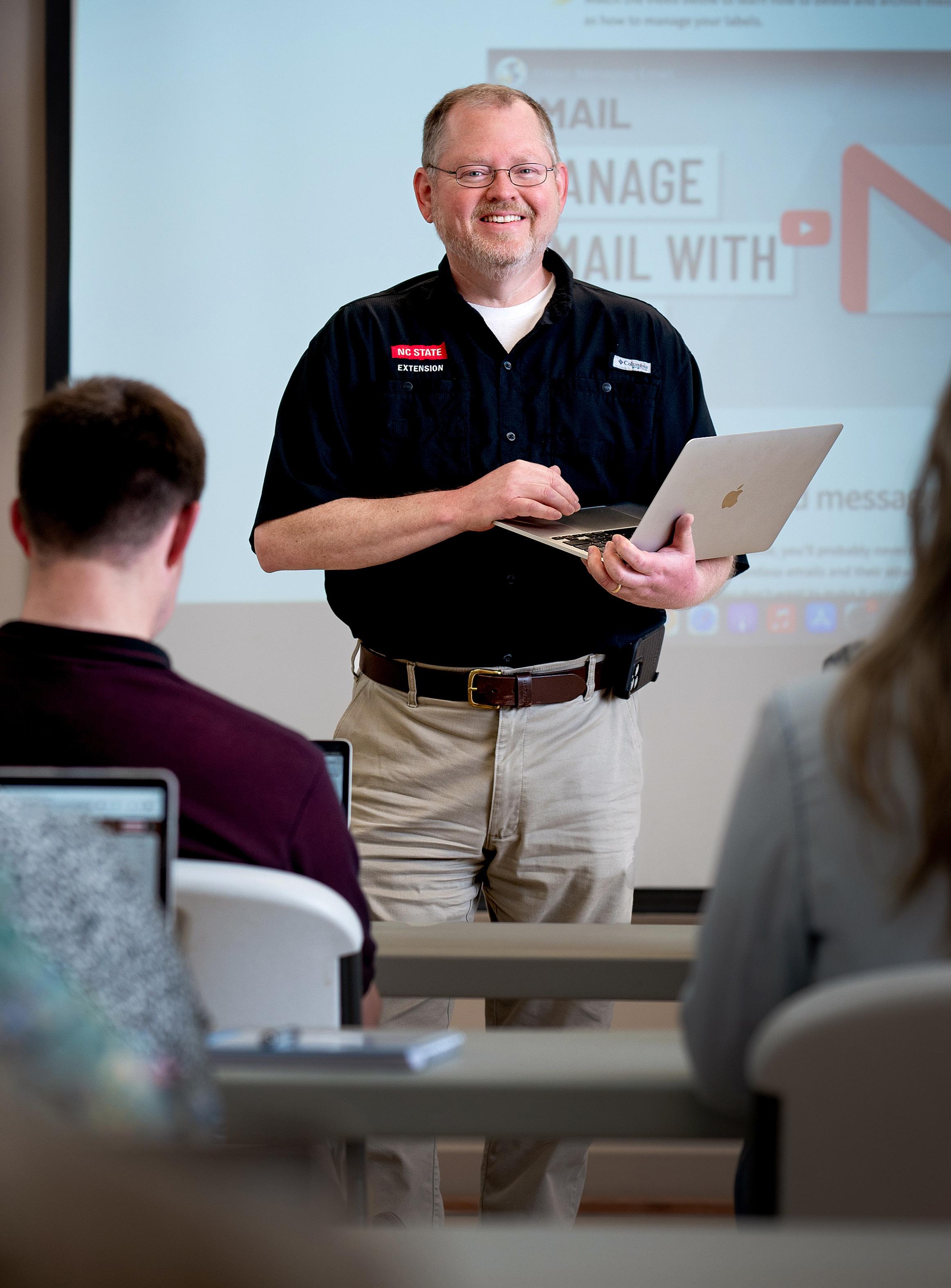
“My vision is to help North Carolina residents earn, learn and be well using digital resources.”

“
...we have some big problems to solve, like global warming, pests, drought and an increasing global population. We really need bright people with diverse opinions and tools to address these problems.”
Terri Long rarely turns down the opportunity to help.
“If I’m asked to participate, and I feel like I’m going to help someone, I’ll give it a shot,” says Long, a professor in North Carolina State University’s Department of Plant and Microbial Biology. “I want to help people in any way I’m called to do so.”
Long has dedicated her career to creating opportunities for students, and a new appointment as North Carolina Plant Sciences Initiative’s (N.C. PSI) platform director for education and workforce development widens the spectrum of students she’s able to reach.
“I think of this platform as an opportunity to build pathways to plant sciences for students who may not have considered studying plants and agriculture as a career option,” says Long.
Long grew up on a farm in Louisburg, North Carolina, where she developed an interest in plant sciences. But it was always difficult to envision herself, a Black woman, as a scientist.
“I didn’t have mentors who looked like me when I was an undergrad,” says Long. “I had one Black female teaching assistant and one Black male faculty member. He was one of my favorite professors because he looked like me. That inspired me.”
Now, Long gets to return the favor as a mentor, touching lives from kindergarten to postdoctoral research, with the goal of giving students the opportunity to see people who look like them in positions they’d like to one day have.
“It’s not just students from minoritized groups,” says Long. “It’s any student who’s interested in plants and who wants to learn more and work towards a successful and impactful career.”
For K-12 outreach, Long provides students with the chance to tour the NC State University Plant Sciences Building (PSB) to meet scientists and participate in hands-on activities in the Demo Lab. She has also worked with Catalyst, a high school program designed to create STEM opportunities for students with disabilities, provide lab experiences and offer other K-12 outreach programs.
By Emma MacekFor undergraduate and graduate students at NC State and beyond, she has promoted internship and networking opportunities, helped coordinate funds for minority students to travel to national and international scientific conferences, and created opportunities to visit local N.C. PSI industry partners.
Long’s work also expands beyond the university. She’s helping to develop a 4-H curriculum on plant sciences, working with the Math and Science Engineering Network to create lab experiences at NC State for rural students, and collaborating with several groups to host the Inaugural Plant Sciences Day for high school students at the PSB. She’s also planning activities at the building for students attending the state FFA convention in June.
“I enjoy working with others to expose a young person to an opportunity that they never would’ve thought of,” says Long. “Now that you’ve opened up a door for them, they could potentially walk through it and create a whole new career pathway for themselves. Thirty years from now, that person could be a Nobel Prize winner.”
While building up the next generation of scientists, Long is committed to increasing diversity in the scientific community as a member of several diversity and inclusion committees. For her, diverse thinking is essential for advancing plant science: “We can’t come up with new ideas if everyone thinks the same.”
Long adds, “Diversity is important because we have some big problems to solve, like global warming, pests, drought and an increasing global population. We need bright people with diverse opinions and tools to address these problems.”
In the future, Long hopes to help underrepresented students develop laboratory technical skills so they have more competitive applications for graduate school and to increase her involvement with workforce development organizations across the state.
“I want to be impactful. I think that’s what we all want,” says Long. “We want to impact other people in a positive way. Also, I love plants. I’ve been fascinated with plants since I was young, and I want more people to realize how fascinating and important plants are.” >
When an aged whiskey or rum hits your palate, you are tasting a years-long process. After fermenting and distilling, the astringent, clear liquor is stored in a wood barrel where it develops its amber-to-dark brown color and flavors of vanilla, pepper, nuts and even caramel and mint from the wood tannins. The tannins are also to thank for mellowing the harsh flavors of alcohol. Highend rum and whiskey may sit in barrels for years, sometimes decades.
Many in the industry believe the aging process that gives distilled liquors their je ne sais quoi is intangible and mysterious. But Assistant Professor Marvin Moncada says he can develop flavor, color and smooth-tasting rum and whiskey in a fraction of the time.
“We are aging rum in 21 days, and it is the equivalent of a 5-year-old rum in flavor and alcohol level,” says Moncada. “And it tastes amazing.”
Moncada—a native of Honduras—came to NC State’s Department of Food, Bioprocessing and Nutrition Sciences with a research focus on creating functional ingredients and food products by upcycling wasted raw materials and byproducts. This includes but is not limited to plantbased protein concentrate production, rare sugar recovery, lipid recovery and bioactive extraction. He first became interested in rum distilling on a project at his previous position at Louisiana State University.
“While in Louisiana, I helped a distiller with some analysis on their rum, and I realized that in order to have a good rum to go on the market, they had to wait five to seven years to complete the aging,” Moncada explains. “As an innovator, I started thinking how can I make the process quicker? It’s an opportunity to help the industry. I started analyzing what happens in the barrel
over time—the tannins of the wood that are getting in the rum, the astringent alcohol that’s going back into the wood—and how I could manipulate those conditions.”
In his lab at the Plants for Human Health Institute, Moncada started testing half-liter samples with a water-bath method using a low temperature to retain volatile compounds that are sensitive to heat. He also played with natural light, LED light and a blend of wood to speed the aging process and develop flavor.
“In 21 days, we found very significant color change and taste,” says Moncada. “In collaboration with Dr. Slavko Komarnytsky’s lab, we identified the gas chromatography compounds, so we know how the chemistry changed.”
Now Moncada is working on scaling-up the process. He designed a 20-gallon rapid distiller and is consulting with the NC State College of Engineering to build it. He hopes to run larger experiments and further test the patent-pending process.
“The cost of aging spirits is significant, and handling large volumes creates strategic problems as the demand for spirits increases,” Moncada explains.
“The accelerated aging methodology is a sustainable process that involves the use of naturally occurring, energy-efficient, environmentally friendly processes and avoids the use of chemical reagents.”
By eliminating the need for barrel aging, his invention will also save distillers money and time.
“This groundbreaking clean-label technology will allow the distillery industry to have a more sustainable, cost-effective production and an aged product in less than a month,” he says. “Small distillers new to the industry may be able to adopt it and have a quality product that is cheaper to produce, and people will enjoy it because it is very smooth.”
go.ncsu.edu/MarvinMoncada

“We are aging rum in 21 days, and it is the equivalent of a 5-yearold rum in flavor and alcohol level. And it tastes amazing.”4-H Summer Camp
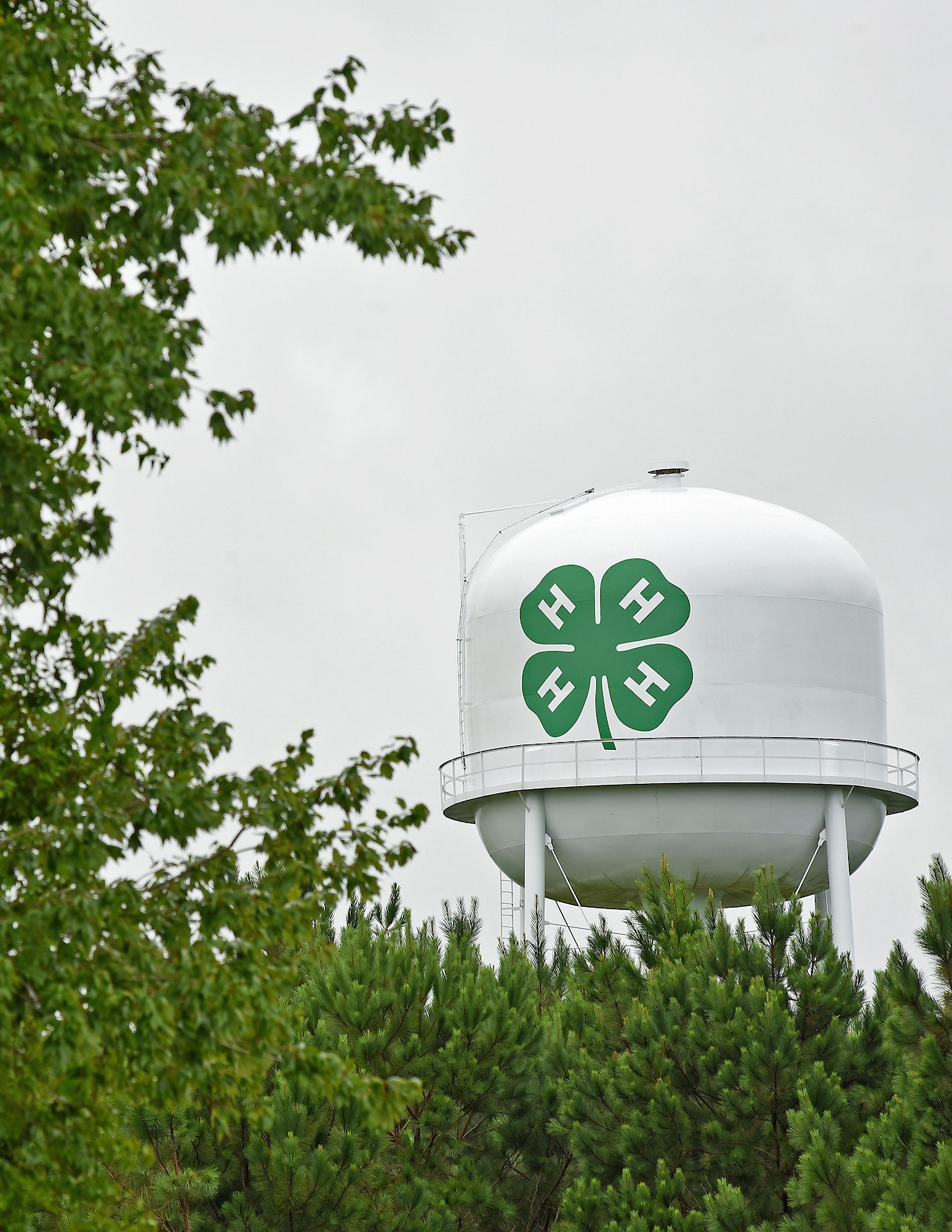
As summer approaches, thoughts turn toward a relaxed, carefree time. For many of us, summer plans are already in the works—the family vacation, weekends at the pool and, best of all, summer camp for the kids.
While summer is a time of great anticipation for most children, for others it can be a daunting time filled with uncertainty, lack of a clear schedule, and sometimes even hunger as school breakfast and lunch programs take a break.
Economic disadvantages manifest themselves in many ways, from the child lacking supervision because a single parent works three jobs to pay for rent and food, to the foster child bounced from home to home because of trauma that was not their fault, to the teen living in a home where there is drug abuse or other addictions. Kids facing situations like these need a supportive adult to help them clear the hurdles life has in store for them.
Summer vacation and summer camp have just been more dreams unfulfilled. For 4-H agents and staff, those are kids’ dreams worth fulfilling.
4-H is the largest youth organization in North Carolina, serving more than 200,000 children and teens statewide through local Cooperative Extension centers in every county. And most of those counties make visits to 4-H summer camps a reality for local youth. While many kids attending camp have parents or grandparents paying their camp tuition, about one-third of campers could not afford to attend without the work of dedicated 4-H, Extension and partner staff, as well as program donors.
“4-H, at both the national and state levels, wants to provide the summer camp opportunity to every youth. But there have been times when our national organization has not had the resources to fund scholarships. In 2019, NC 4-H established our own state scholarship program, and we work hard to find the funds to serve the most vulnerable,” said Angela Brisson, 4-H camping program assistant for NC State Extension.
The state scholarship program has historically provided camp to most kids who apply. About 175 youth attending 4-H summer camp in 2022 did so thanks to state funds, donor gifts and the hard work of 4-H camp staff. For vulnerable young people, Brisson said, the experience is priceless.
“The 4-H camp model naturally facilitates positive mental health outcomes for youth, and camp becomes a place of belonging and family. Our camp staff receive specialized training to meet the needs of our most vulnerable campers.”
NC State Extension and 4-H work hard to educate potential financial donors about the opportunity to provide disadvantaged kids with “camperships,” 4-H camps’ version of a scholarship, and a number of agents across the state go the extra mile to bring the dream of camp to deserving children. >
“The 4-H camp model naturally facilitates positive mental health outcomes for youth, and camp becomes a place of belonging and family.”
Angela Brisson 4-H camping program assistant for NC State Extension
For Ginger Cunningham and Liz Mauney in Chatham County, a single extra mile is not enough. These dedicated 4-H educators go miles beyond the expected.
“Youth can find a safe place in 4-H,” said Cunningham, the county Extension director and 4-H youth development agent, “so we partner with organizations as a way to find youth that need help.”
Communities in Schools (CIS) in Chatham County is one such organization. Cunningham and Mauney, a 4-H program assistant, work closely with Shirille Lee, CIS’ General Youth Services’ Youth First program coordinator, to identify and support vulnerable kids who would benefit from 4-H summer camp.
When Mauney and Cunningham started working in Chatham County, the partnership between Extension and CIS had already been built. “From Shirille I learned that what I see of local youth is not the full picture. I realized that I can’t see what (their) home life is like,” Cunningham said.
With the help of Lee, CIS children could not only be better identified, but it became far easier to connect with guardians. “We tried to get at-risk kids to be a part of our camp program, but found that they don’t always have access to computers. Now, Shirille gets the information from 4-H online out to everyone,” Mauney said. “Having a trusted partner at CIS keeps the mission going.”
“When Ginger came on board at 4-H, CIS was struggling to get kids to camp. Camp forms were a barrier as few families completed them on time. Our partnership with 4-H has changed that,” said Lee. “About 85% of our CIS kids are from singleparent homes. Parents don’t have time to check homework, go to ball games and fill out forms. We provide volunteers to work with youth, who can go to school and check in, and who can connect with parents,” she said of CIS’ role.
Cunningham and Mauney praise CIS’ logistical support as well as the support received from other partners. “We have been blessed with funds from the United Way that we have used for transportation and camp scholarships. Where our funding has, at times, been cut short, partners
have stepped up. FACES of Chatham has been a great new partner, helping with funding but also with mentoring youth,” Mauney said. “In Chatham, we have built a support system to both find the youth and to find the people that can help remove the financial barriers.”
“Summer camp is the ultimate opportunity for our children to get away from home and establish a certain amount of independence. They meet other kids from other parts of the state; they make new friends and they experience new things,” Lee said. Without 4-H and donor support, at-risk children might not get the opportunity.
“Camp has a huge impact on our kids. They hear the stories of other kids and it helps them evaluate their own lives. The value of camp—I can’t even explain it,” she said.
Mauney agreed. “Camp is their time to be kids. Camp is fun. You don’t have to worry about meals, about having a bed or about having structure. This is their vacation.”
Camp experiences can have a profound impact, Brisson said.
At-risk “kids are often dealing with really big problems in their day-to-day lives, but when they come to camp, the biggest challenges they face are things like making sure they have their water shoes for canoeing or not burning their marshmallows at campfire,” Brisson said. “That may seem small, but it’s a huge opportunity where they get to just be a kid for a week, to live and play in a safe, supportive environment with caring adults.
“That has a lasting impact far beyond the week of camp.”
For Cunningham, there is no question of why camp is important to at-risk youth. “We take them to camp, then encourage them to participate in 4-H. For some kids, camp is a week away from wherever they find themselves living,” she said. “It is a week of something steady and steadfast. In the words of one of our former campers, ‘There was always camp.’”


“I have some good memories from camp. My favorite accomplishments were getting on a zipline and rock climbing, and we built a raft out of PVC pipes and rope so we could float on the lake. Then we went camping overnight.”
Layla, 4-H camper
continued from page 1
What’s it like to work with someone for 20 years—41,600 hours of shared team meetings, career milestones and Monday mornings?
For Lake Wheeler Road Field Lab colleagues Chad Carter, Philip Newton and Bill Whaley, it means learning each other’s working styles, morning routines—and senses of humor.
“Twenty years, that’s a pretty long prison sentence,” Whaley says, sending Carter and Newton into peals of laughter.
“I mean, it could be worse than these guys,” Newton adds. “... I guess.” More laughter.
“We’ve been working together longer than we haven’t been working together, when you think about it,” Carter says, getting serious.
“It’s not so bad,” Whaley admits. “We’re pretty much like family by now.”
For 20 years, these Agricultural Institute alums have helped maintain the field lab as a thriving farm, vital research facility and hands-on classroom. Their boss, Superintendent Bridget Lassiter, calls the trio her “right-hand men” during a pivotal moment, as the university invests in making the farm future-ready.


Lassiter credits Carter, Newton and Whaley as crucial to that mission.
“They hold this farm together,” she says. “Here’s what you should write: ‘Bridget Lassiter couldn’t do her job without them—and she wouldn’t want to.’”
If you’ve never had the chance to visit the field labs, picture 1,800 acres of rolling green farmland less than five miles from Patterson Hall.

“I don’t know of many capital cities that have urban agriculture and research farms this close to downtown and to a major university,” Carter says. “It’s an incredible resource—within 10 minutes of leaving the classroom, NC State students can be on a farm, learning and working.”
Carter’s first experience at the field labs was as a student. He, Newton and Whaley graduated in 2000 from the Agricultural Institute, CALS’ streamlined twoyear agriculture degree program. CALS snapped up all three men as employees within a year of their graduation. Carter is now a research operation manager. Newton oversees field operations and animal waste management. Whaley is building and maintenance supervisor.
Lassiter likes to boast about their combined 60 years of on-site experience, which she says was important when she became superintendent.
Being the new boss can be tricky enough, but Lassiter has also been charged with making changes to daily operations by updating policies and procedures. Lassiter relied on Carter, Newton and Whaley to help integrate changes without losing time or disrupting staff morale.
“They’re my early adopters,” Lassiter says. “They tell me what’s doable and when, based on their knowledge of the facilities and the teams.”
Personality-wise, the men couldn’t be more different. At a typical team meeting, Carter is outgoing—“everybody on the
farm knows Chad,” Lassiter says. Whaley checks in quietly with his colleagues one by one. Newton rarely talks at all, Lassiter says, “unless somebody uses the wrong numbers.”
In 20 years, each of the men has built a reputation, and Newton’s near-photographic memory for data is legendary: When a barn burned down in 2021, he remembered the model number of every piece of equipment stored there, plus prices and dates of purchase.
Likewise, Whaley is on speed-dial for every aspect of maintenance for the 200 buildings and countless miles of fences and landscaping, from stuck gates to the Wi-Fi connection. Carter’s network is wide-ranging; he attends universitywide strategy meetings with Lassiter and translates that vision to the team.
Despite their differences, the men work together seamlessly. When a tropical storm threatened Raleigh during the sorghum harvest, two decades of shared priorities and experience kicked in: One quick phone call was all it took for each man to jump into a truck and take off for different parts of the farm. It took them four consecutive 16-hour workdays, but Lake Wheeler didn’t lose a single sorghum plant to the storm. The men finished the harvest just a few minutes before the rain began.
When you boil it down, the men agree, what those 41,600 hours working together adds up to is both simple and rare: 20 years of earned trust in each other’s competence, work ethic and integrity.
“I wouldn’t want to do this job without them,” Lassiter says. “I learn something new from them every day.” CHELSEA
KELLNER
“I don’t know of many capital cities that have urban agriculture and research farms this close to downtown and to a major university. It’s an incredible resource— within 10 minutes of leaving the classroom, NC State students can be on a farm, learning and working.”
Chad Carter
When Bonnie Davis became Orange County’s first Black home demonstration agent in 1950, she didn’t have a proper office, a demonstration kitchen or even an indoor bathroom she and her club members could use.

Now, her successors in North Carolina Cooperative Extension and their clientele of all races have access to a state-of-theart building that perpetuates her legacy. Dedicated in 2021, the Bonnie B. Davis Environment and Agricultural Center houses several agencies, including Extension, a partnership of NC State Extension, NC A&T State University Cooperative Extension and the county and federal governments.
Her impact extended beyond knowledge of cooking, nutrition, family financial management, home care and health she shared through Extension. Throughout her 40-year career and well into retirement, Davis prized partnerships, working with government agencies and private
organizations to push for equality, justice and human rights.
Davis died in 2018, but her reputation as a calming influence during difficult times, including the turbulent years of racial integration, persists.
Davis prioritized education. Her daughter, Bonita D. Neighbors, recalled that Davis often said, “‘No one can take from you what you have between your ears.’”
Ivelisse Colón, Family and Consumer Sciences Extension agent in Orange County, began the grassroots effort to name the new building after Davis.
“Number one, she encountered segregation and went head on against it,” Colón said. “Number two, she was a force to be reckoned with in the community. She would help people regardless of their economic status, race, ethnicity or beliefs.
“Her example is one to remember now and for all times.” DEE SHORE
“Her example is one to remember now and for all times.”
Ivelisse Colón
Family and Consumer Sciences agent, Orange County
go.ncsu.edu/BonnieDavis
Honey bees play a vital role in pollination and as a critical link in agriculture production. How vital? The collapse of the honey bee population would lead to the collapse of the national and global food supply.
“Bee” a part of the solution and grow the North Carolina State Bee Keepers Association Faculty Award in Apiculture to a Distinguished Professorship. Help establish an endowed honey bee research program like no other in the United States and advance honey bee health for generations to come.

Join the hive.
go.ncsu.edu/bee-fund

Campus Box 7603
Raleigh, NC 27695
This is just one of over 20 locations at the Lake Wheeler Road Field Lab where NC State’s “Think and Do” approach comes to life every day. Our cover story explains.
